Leeds
Leeds | |
|---|---|
City | |
| City of Leeds | |
 Clockwise from top left: Leeds Town Hall, Bridgewater Place, Leeds Minster, Skyline of Leeds with the minster in foreground, Leeds railway station, Leeds Civic Hall, Trinity Leeds,
Leeds Skyline with the city centre and town hall in foreground | |
 Shield | |
| Motto(s): Pro rege et lege (Latin: "For king and the law") | |
 Shown within West Yorkshire | |
 Leeds Location within England | |
| Coordinates: 53°47′59″N 1°32′57″W / 53.79972°N 1.54917°WCoordinates: 53°47′59″N 1°32′57″W / 53.79972°N 1.54917°W | |
| Sovereign state | United Kingdom |
| Country | England |
| Region | Yorkshire and the Humber |
| County | West Yorkshire |
| Borough | City of Leeds |
| Historic county | Yorkshire, West Riding |
| Borough charter | 1207 |
| Municipal charter | 1626 |
| City status | 1893 |
| Administrative HQ | Leeds Civic Hall, Millennium Square |
| Government | |
| • Type | Metropolitan borough |
| • Body | Leeds City Council |
| • Leadership | Leader and cabinet |
| • Executive | Labour |
| • Lord Mayor | Asghar Khan |
| • Council Leader | James Lewis |
| • Chief Executive | Tom Riordan |
| Area | |
| • Borough | 213.0 sq mi (551.7 km2) |
| • Urban | 188.3 sq mi (487.8 km2) |
| Area rank | 83rd |
| Highest elevation | 1,115 ft (340 m) |
| Lowest elevation | 33 ft (10 m) |
| Population (mid-2019 est.) | |
| • Borough | 793,139 |
| • Rank | 2nd |
| • Density | 3,700/sq mi (1,430/km2) |
| • Urban [dubious ] | 1,901,934 (4th) |
| • Urban density | 9,440/sq mi (3,645/km2) |
| • Metro [dubious ] | 2,638,127 (4th) |
| • Ethnicity (2011 census)[3] | 85% White 5.7% Asian or Asian British 3.5% Black or Black British 2.7% Mixed Race 3.1% Other |
| Demonym(s) | Loiner, Leodensian |
| Time zone | UTC+0 (Greenwich Mean Time) |
| • Summer (DST) | UTC+1 (British Summer Time) |
| Postcode areas | LS WF, BD (parts) |
| Dialling codes | 0113 (Leeds) 01937 (Wetherby) 01943 (Guiseley) |
| ISO 3166 code | GB-LDS |
| GSS code | E08000035 |
| NUTS 3 code | UKE42 |
| ONS code | 00DA |
| OS grid reference | SE296338 |
| Motorways | M1 M62 M621 A1(M) A58(M) A64(M) |
| Major railway stations | Leeds (A) |
| International airports | Leeds Bradford (LBA) |
| GDP | US$82.98 billion[4][5] |
| – Per capita | US$33,355[4] |
| GVA (2015) | £21.3bn (4th) |
| – Per capita | £27,466 (4th) |
| Councillors | 99 |
| MPs | List of MPs |
| Website | www.leeds.gov.uk |
Leeds is the largest city in the county of West Yorkshire, England. Leeds is to the east of Bradford, north of Sheffield, south-west of York, and north-east of Manchester. The city forms the core of the City of Leeds metropolitan borough, which also includes the towns of Horsforth, Morley, Otley, Pudsey, Rothwell and Wetherby.[6]
Leeds was a small manorial borough in the 13th century, becoming a major centre for the production and trading of wool in the 17th and 18th centuries, then a major mill town during the Industrial Revolution; wool was still the dominant industry, but flax, engineering, iron foundries, printing, and other industries were also important.[7] From being a market town in the valley of the River Aire in the 16th century, Leeds expanded and absorbed the surrounding villages to become a populous urban centre by the mid-20th century. Leeds attained City status in 1893.
Leeds (with a 474,632 population) is the largest subdivision of the West Yorkshire Built-up Area (2011 census classification) and the Yorkshire and Humber region's most populous. West Yorkshire BUA is the UK's fourth-most populous urban area with a reported population of 1.8 million in 2013. The metropolitan borough governed from the city had a population of 793,139, the 2nd most populous district in England.[8]
History[]
Toponymy[]
The name derives from the old Brythonic word Ladenses meaning "people of the fast-flowing river", in reference to the River Aire that flows through the city.[9] This name originally referred to the forested area covering most of the Brythonic kingdom of Elmet, which existed during the 5th century into the early 7th century.[10]
Bede states in the fourteenth chapter of his Ecclesiastical History, in a discussion of an altar surviving from a church erected by Edwin of Northumbria, that it is located in ...regione quae vocatur Loidis (Latin, "the region which is called Loidis"). An inhabitant of Leeds is locally known as a Loiner, a word of uncertain origin.[11] The term Leodensian is also used, from the city's Latin name.
The name has also been explained as a derivative of Welsh lloed, meaning simply "a place".[12]
Economic development[]

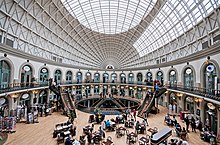
Leeds developed as a market town in the Middle Ages as part of the local agricultural economy.
Before the Industrial Revolution, it became a co-ordination centre for the manufacture of woollen cloth, and white broadcloth was traded at its White Cloth Hall.[13]
Leeds handled one sixth of England's export trade in 1770.[14] Growth, initially in textiles, was accelerated by the creation of the Aire and Calder Navigation in 1699 (with major additional works in the 18th century) and the Leeds and Liverpool Canal in 1816.[15] In the late Georgian era, William Lupton was one of a number of central Leeds landowners, some of whom, like him, were also textile manufacturers. At the time of his death in 1828, Lupton occupied the enclosed fields of the manor of Leeds, his estate including a mill, reservoir, substantial house and outbuildings.[16][17]
Mechanical engineering, initially to supply tools and machinery for the textile sector, rapidly became a diverse industry.[18]
The railway network constructed around Leeds, starting with the Leeds and Selby Railway in 1834, provided improved communications with national markets and, significantly for its development, an east–west connection with Manchester and the ports of Liverpool and Hull giving improved access to international markets.[19] Alongside technological advances and industrial expansion, Leeds retained an interest in trading in agricultural commodities, with the Corn Exchange opening in 1864.
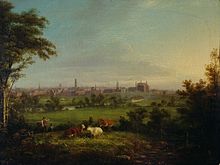
Marshall's Mill was one of the first of many factories constructed in Leeds from around 1790 when the most significant were woollen finishing and flax mills.[20] Manufacturing diversified by 1914 to printing, engineering, chemicals and clothing manufacture.[21] Decline in manufacturing during the 1930s was temporarily reversed by a switch to producing military uniforms and munitions during the Second World War. However, by the 1970s, the clothing industry was in irreversible decline, facing cheap foreign competition.[22] The contemporary economy has been shaped by Leeds City Council's vision of building a '24-hour European city' and 'capital of the north'.[23] The city has developed from the decay of the post-industrial era to become a telephone banking centre, connected to the electronic infrastructure of the modern global economy.[23] There has been growth in the corporate and legal sectors,[24] and increased local affluence has led to an expanding retail sector, including the luxury goods market.[25]
Leeds City Region Enterprise Zone was launched in April 2012 to promote development in four sites along the A63 East Leeds Link Road.[26]
Local government[]
| 1881 | 160,109 |
|---|---|
| 1891 | 177,523 |
| 1901 | 177,920 |
| 1911 | 259,394 |
| 1921 | 269,665 |
| 1931 | 482,809 |
| 1941 | war* |
| 1951 | 505,219 |
| 1961 | 510,676 |
| *no census was held due to war | |
| source: UK census[27] | |
Leeds was a manor and township in the large ancient parish of Leeds St Peter, in the Skyrack wapentake of the West Riding of Yorkshire.[28] The Borough of Leeds was created in 1207, when Maurice Paynel, lord of the manor, granted a charter to a small area of the manor, close to the river crossing, in what is now the city centre. King James I granted the borough to his wife, Anne of Denmark, and in 1612, she ordered a survey of the borough; in 1615 she was petitioned to remove the strict Calvinist preacher Alexander Cooke as vicar of Leeds, but she refused.[29]
The inhabitants petitioned Charles I for a charter of incorporation, which was granted in 1626. The new charter incorporated the entire parish, including all eleven townships, as the Borough of Leeds and withdrew the earlier charter. Improvement commissioners were set up in 1755 for paving, lighting, and cleansing of the main streets, including Briggate and further powers were added in 1790 to improve the water supply.[30]
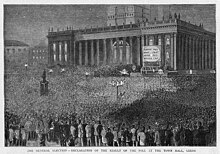
The borough corporation was reformed under the provisions of Municipal Corporations Act 1835. Leeds Borough Police force was formed in 1836, and Leeds Town Hall was completed by the corporation in 1858. In 1866, Leeds and each of the other townships in the borough became civil parishes. The borough became a county borough in 1889, giving it independence from the newly formed West Riding County Council and it gained city status in 1893. In 1904 the Leeds parish absorbed Beeston, Chapel Allerton, Farnley, Headingley cum Burley and Potternewton from within the borough. In the twentieth century the county borough initiated a series of significant territorial expansions, growing from 21,593 acres (87.38 km2) in 1911 to 40,612 acres (164.35 km2) in 1961.[31] In 1912 the parish and county borough of Leeds absorbed Leeds Rural District, consisting of the parishes of Roundhay and Seacroft; and Shadwell, which had been part of Wetherby Rural District. On 1 April 1925, the parish of Leeds was expanded to cover the whole borough.[28]
The county borough was abolished on 1 April 1974, and its former area was combined with that of the municipal boroughs of Morley and Pudsey; the urban districts of Aireborough, Horsforth, Otley, Garforth and Rothwell; and parts of the rural districts of Tadcaster, Wetherby, and Wharfedale.[32] This area formed a metropolitan district in the county of West Yorkshire. It gained both borough and city status and is known as the City of Leeds. Initially, local government services were provided by Leeds City Council and West Yorkshire County Council. When the county council was abolished in 1986, the city council absorbed its functions, and some powers passed to organisations such as the West Yorkshire Passenger Transport Authority. From 1988 two run-down and derelict areas close to the city centre were designated for regeneration and became the responsibility of Leeds Development Corporation, outside the planning remit of the city council.[33] Planning powers were restored to the local authority in 1995 when the development corporation was wound up.
Suburban growth[]
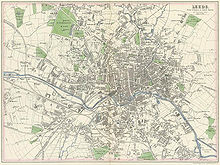
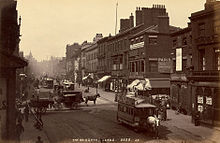
In 1801, 42% of the population of Leeds lived outside the township, in the wider borough. Cholera outbreaks in 1832 and 1849 caused the authorities to address the problems of drainage, sanitation, and water supply. Water was pumped from the River Wharfe, but by 1860 it was too heavily polluted to be usable. Following the Leeds Waterworks Act of 1867 three reservoirs were built at Lindley Wood, Swinsty, and Fewston in the Washburn Valley north of Leeds.[34]
Residential growth occurred in Holbeck and Hunslet from 1801 to 1851, but, as these townships became industrialised new areas were favoured for middle class housing.[35] Land south of the river was developed primarily for industry and secondarily for back-to-back workers' dwellings. The Leeds Improvement Act 1866 sought to improve the quality of working class housing by restricting the number of homes that could be built in a single terrace.[36]
Holbeck and Leeds formed a continuous built-up area by 1858, with Hunslet nearly meeting them.[37] In the latter half of the nineteenth century, population growth in Hunslet, Armley, and Wortley outstripped that of Leeds. When pollution became a problem, the wealthier residents left the industrial conurbation to live in Headingley, Potternewton and Chapel Allerton which led to a 50% increase in the population of Headingley and Burley from 1851 to 1861. The middle-class flight from the industrial areas led to development beyond the borough at Roundhay and Adel.[37] The introduction of the electric tramway led to intensification of development in Headingley and Potternewton and expansion outside the borough into Roundhay.[38]
Two private gas supply companies were taken over by the corporation in 1870, and the municipal supply provided street lighting and cheaper gas to homes. From the early 1880s, the Yorkshire House-to-House Electricity Company supplied electricity to Leeds until it was purchased by Leeds Corporation and became a municipal supply.[39]
Slum clearance and rebuilding began in Leeds during the interwar period when over 18,000 houses were built by the council on 24 estates in Cross Gates, Middleton, Gipton, Belle Isle and Halton Moor. The slums of Quarry Hill were replaced by the innovative Quarry Hill flats, which were demolished in 1975. Another 36,000 houses were built by private sector builders, creating suburbs in Gledhow, Moortown, Alwoodley, Roundhay, Colton, Whitkirk, Oakwood, Weetwood, and Adel. After 1949 a further 30,000 sub-standard houses were demolished by the council and replaced by 151 medium-rise and high-rise blocks of council flats in estates at Seacroft, Armley Heights, Tinshill, and Brackenwood.[40]
Leeds has seen great expenditure on regenerating the city, attracting in investments and flagship projects,[41] as found in Leeds city centre. Many developments boasting luxurious penthouse apartments have been built close to the city centre.
Geography[]

Leeds is located 169 miles (272 km) north-northwest of London,[42] on the valley of the River Aire in the eastern foothills of the Pennines. The city centre lies in a narrow section of the Aire Valley at about 206 feet (63 m) above sea level; while the district ranges from 1,115 feet (340 m) in the far west on the slopes of Ilkley Moor to about 33 feet (10 m) where the rivers Aire and Wharfe cross the eastern boundary. There are also significant variations in elevation within the city itself. For example, land rises to 198 m (650 ft) in Cookridge, just 6 miles (9.7 km) from the city centre. The centre of Leeds is part of a continuously built-up area extending to Pudsey, Bramley, Horsforth, Alwoodley, Seacroft, Middleton and Morley.[43]
Leeds has the second-highest population of any local authority district in the UK (after Birmingham), and the second-greatest area of any English metropolitan district (after Doncaster), extending 15 miles (24 km) from east to west, and 13 miles (21 km) from north to south. The northern boundary follows the River Wharfe for several miles (several kilometres), but it crosses the river to include the part of Otley which lies north of the river.
The city centre is less than twenty miles (32 km)) from the Yorkshire Dales National Park,[44] which has some of the most spectacular scenery and countryside in the UK.[45] Inner and southern areas of Leeds lie on a layer of coal measure sandstones forming the Yorkshire Coalfield. To the north parts are built on older sandstone and gritstones and to the east it extends into the magnesian limestone belt.[20][46][47] The land use in the central areas of Leeds is overwhelmingly urban.[43]
Attempts to define the exact geographic meaning of Leeds lead to a variety of concepts of its extent, varying by context include the area of the city centre, the urban sprawl, the administrative boundaries, and the functional region.[48]
Leeds is much more a generalised concept place name in inverted commas, it is the city, but it is also the commuter villages and the region as well.
— Brian Thompson, A History of Modern Leeds[48]
Leeds city centre is contained within the Leeds Inner Ring Road, formed from parts of the A58 road, A61 road, A64 road, A643 road and the M621 motorway. Briggate, the principal north–south shopping street, is pedestrianised and Queen Victoria Street, a part of the Victoria Quarter, is enclosed under a glass roof. Millennium Square is a significant urban focal point. The Leeds postcode area covers most of the City of Leeds[49] and is almost entirely made up of the Leeds post town.[50] Otley, Wetherby, Tadcaster, Pudsey and Ilkley are separate post towns within the postcode area.[50] Aside from the built up area of Leeds itself, there are a number of suburbs and exurbs within the district.
Watercourses[]
In addition to the rivers Aire and Wharfe, other watercourses (generally known as becks) include:
- Adel Beck, which flows southwards from Adel Dam and through Adel Woods to join Meanwood Beck just south of the Leeds Outer Ring Road.
- Bramhope Beck, Bramhope
- Brandon Drain Stream, Shadwell[51]
- Cock Beck
- Collingham Beck, which enters the Wharfe near Collingham
- Colton Beck, near Colton, which may have been diverted during the medieval period to power a mill or support a moat [52]
- River Crow, which flows in the vicinity of Aberford and joins the Wharfe near Tadcaster[53]
- Dolphin Beck, Thorpe
- Eccup Beck
- Gledhow Beck, flowing through Gledhow Valley Woods into Gledhow Lake
- Grace Beck, in Wike
- Great Heads Beck, flowing into Waterloo Lake in Roundhay Park
- Guiseley Beck [54]
- Haigh Beck, Rothwell
- Hol Beck
- Keswick Beck, a tributary of Collingham Beck
- Marsh Beck, which flows into Golden Acre Park
- Meanwood Beck (different portions are also referred to as Adel Beck, Carr Beck, Lady Beck, Mabgate Beck, Sheepscar Beck and Timble Beck)[55]
- Mill Beck
- Mill Shaw Beck, which flows near Elland Road [56]
- Mire Beck, near Menston and Guiseley Moor [57]
- Moseley Beck
- Oil Mill Beck, near Horsforth [58]
- Pudsey Beck
- Shadwell Beck
- Shaw Beck
- Stank Beck, flowing through the grounds of Harewood House northwards to the River Wharfe near Harewood Bridge
- Throstle Carr Beck, Middleton
- Topcliffe Beck, Morley
- Wigton Knowle Beck, in Alwoodley, flowing northwards into Eccup Reservoir
- Wortley Beck, flowing through woodlands maintained by Leeds City Council [59]
- Wyke Beck
Climate[]
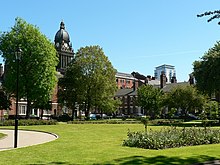
Leeds has a climate that is oceanic (Köppen: Cfb), and influenced by the Pennines. Summers are usually mild, with moderate rainfall, while winters are chilly, cloudy with occasional snow and frost. The nearest official weather recording station is at Bingley, some twenty kilometres away at a higher altitude.[60]
July is the warmest month, with a mean temperature of 16 °C (61 °F), while the coldest month is January, with a mean temperature of 3 °C (37 °F). Temperatures above 30 °C (86 °F) and below −10 °C (14 °F) are not very common but can happen occasionally. Temperatures at Leeds Bradford Airport fell to −12.6 °C (9.3 °F) in December 2010[61] and reached 31.8 °C (89 °F) at Leeds city centre in August 2003.[62] The record temperature for Leeds is 34.4 °C (94 °F) during the early August 1990 heatwave. It is possible this was exceeded during the heatwave of July 2019 where many other areas broke their all time records. However Leeds weather centre closed in the 2000s.
As is typical for many sprawling cities in areas of varying topography, temperatures can change depending on location. Average July and August daytime highs exceed 22 °C (72 °F) (a value comparable to South East England) in a small area just to the south east of the city centre,[63][64] where the elevation declines to under 20 metres (66 feet). This is 2 °C (3.6 °F) milder than the typical summer temperature at Leeds Bradford airport weather station (shown in the chart below), at an elevation of 208 metres (682 feet).
Situated on the eastern side of the Pennines, Leeds is among the driest cities in the United Kingdom, with an annual rainfall of 660 mm (25.98 in).
Though extreme weather in Leeds is relatively rare, thunderstorms, blizzards, gale-force winds and even tornadoes have struck the city. The last reported tornado occurred on 14 September 2006, causing trees to uproot and signal failures at Leeds City railway station.[65]
| Climate data for Leeds Bradford | |||||||||||||
|---|---|---|---|---|---|---|---|---|---|---|---|---|---|
| Month | Jan | Feb | Mar | Apr | May | Jun | Jul | Aug | Sep | Oct | Nov | Dec | Year |
| Average high °C (°F) | 5.8 (42.4) |
5.9 (42.6) |
8.7 (47.7) |
11.3 (52.3) |
15 (59) |
18.2 (64.8) |
19.9 (67.8) |
19.9 (67.8) |
17.3 (63.1) |
13.4 (56.1) |
8.8 (47.8) |
6.7 (44.1) |
12.6 (54.6) |
| Average low °C (°F) | 0.3 (32.5) |
0.2 (32.4) |
1.6 (34.9) |
3.1 (37.6) |
5.5 (41.9) |
8.5 (47.3) |
10.4 (50.7) |
10.5 (50.9) |
8.7 (47.7) |
6.3 (43.3) |
2.9 (37.2) |
1.2 (34.2) |
4.9 (40.9) |
| Average precipitation mm (inches) | 61 (2.4) |
45 (1.8) |
52 (2.0) |
48 (1.9) |
54 (2.1) |
54 (2.1) |
51 (2.0) |
65 (2.6) |
57 (2.2) |
55 (2.2) |
57 (2.2) |
61 (2.4) |
660 (25.9) |
| Average precipitation days | 17.5 | 14.2 | 14.8 | 13.5 | 13.7 | 12.2 | 11.7 | 13.2 | 12.9 | 15.1 | 16.5 | 17.0 | 172.3 |
| Source: [66][67] | |||||||||||||
Green belt[]
Leeds is within a green belt region that extends into the wider surrounding counties and is in place to reduce urban sprawl, prevent the settlements in the West Yorkshire conurbation from further convergence, protect the identity of outlying communities, encourage brownfield reuse, and preserve nearby countryside. This is achieved by restricting inappropriate development within the designated areas, and imposing stricter conditions on permitted building.[68]
Over 60% of the Leeds district is green belt land and it surrounds the settlement, preventing further sprawl towards nearby communities. Larger outlying towns and villages are exempt from the green belt area. However, smaller villages, hamlets and rural areas are 'washed over' by the designation. The green belt was first adopted in 1960,[68] and the size in the borough in 2017 amounted to some 33,970 hectares (339.7 km2; 131.2 sq mi).[69]
A subsidiary aim of the green belt is to encourage recreation and leisure interests,[68] with rural landscape features, greenfield areas and facilities including Temple Newsam Park and House with golf course, Rothwell Country Park, Middleton Park, Kirkstall Abbey ruins and surrounding park, Bedquilts recreation grounds, Waterloo lake, Roundhay castle and park, and Morwick, Cobble and Elmete Halls.
Demographics[]
In January 2011, Leeds was named as one of five "cities to watch" in a report published by Centre for Cities.[70] The report shows that the average resident in Leeds earns £471 per week,[71] seventeenth nationally and 30.9% of Leeds residents had NVQ4+ high-level qualifications,[72] fifteenth nationally. Employment in Leeds was 68.8% in the period June 2012 to June 2013, which was lower than the national average, whilst unemployment was higher than the national average at 9.6% over the same time period.[73] It also shows that Leeds will be the least affected major city by welfare cuts in 2014/2015, with welfare cuts of £125 per capita predicted, compared to £192 in Liverpool and £175 in Glasgow.[74] Leeds is overall less deprived than other large UK cities and average income is above regional averages.[75]
Urban subdivision[]
 the West Yorkshire urban area | ||||
| 2001 UK Census |
Leeds USD |
Leeds district |
West Yorks UA |
England (2011) |
|---|---|---|---|---|
| Population | 443,247 | 715,402 | 1,499,465 | 53,012,456 |
| White | 88.4% | 91.9% | 85.5% | 85.4% |
| Asian | 6.4% | 4.5% | 11.2% | 7.8% |
| Black | 2.2% | 1.4% | 1.3% | 3.5% |
| Source: Office for National Statistics[76][77] | ||||
This article needs to be updated. (April 2016) |
At the time of the United Kingdom Census 2001, the Leeds urban subdivision occupied an area of 109 square kilometres (42 sq mi) and had a population of 443,247; making it the fourth-most populous urban subdivision within England and the fifth largest within the United Kingdom. The population density was 4,066 inhabitants per square kilometre (10,530/sq mi), slightly higher than the rest of the West Yorkshire Urban Area. It accounts for 20% of the area and 62% of the population of the City of Leeds. The population of the urban subdivision had a 100 to 93.1 female–male ratio.[78] Of those over 16 years old, 39.4% were single (never married) and 35.4% married for the first time.[79] The urban subdivision's 188,890 households included 35% one-person, 27.9% married couples living together, 8.8% were co-habiting couples, and 5.7% single parents with their children. Leeds is the largest component of the West Yorkshire Urban Area[43] and is counted by Eurostat as part of the Leeds-Bradford larger urban zone. The Leeds travel to work area in 2001 included all of the City of Leeds, a northern strip of the City of Bradford, the eastern part of Kirklees, and a section of southern North Yorkshire; it occupies 751 square kilometres (290 sq mi).
| Year | Pop. | ±% |
|---|---|---|
| 1801 | 94,421 | — |
| 1811 | 108,459 | +14.9% |
| 1821 | 137,476 | +26.8% |
| 1831 | 183,015 | +33.1% |
| 1841 | 222,189 | +21.4% |
| 1851 | 249,992 | +12.5% |
| 1861 | 311,197 | +24.5% |
| 1871 | 372,402 | +19.7% |
| 1881 | 433,607 | +16.4% |
| 1891 | 503,493 | +16.1% |
| 1901 | 552,479 | +9.7% |
| 1911 | 606,250 | +9.7% |
| 1921 | 625,854 | +3.2% |
| 1931 | 646,119 | +3.2% |
| 1941 | 668,667 | +3.5% |
| 1951 | 692,003 | +3.5% |
| 1961 | 715,260 | +3.4% |
| 1971 | 739,401 | +3.4% |
| 1981 | 696,732 | −5.8% |
| 1991 | 716,760 | +2.9% |
| 2001 | 715,404 | −0.2% |
| 2011 | 751,500 | +5.0% |
| Source: Vision of Britain[80] | ||
In 2011, the Leeds USD had a population of 474,632 and had an area of 112 square kilometres (43 sq mi) with a population density of 4,238 inhabitants per square kilometre (10,980/sq mi).[81] It is bounded by, and physically attached to, the other towns of Garforth to the east, Morley to the southwest and Pudsey to the west, all being within the wider borough. 63% of the borough's population of 751,485 live in the USD, while it takes up only 21% of its total area of 552 km2.
| Leeds compared | Leeds USD | Leeds City |
|---|---|---|
| White British | 73.9% | 81.1% |
| Asian | 10.7% | 7.7% |
| Black | 5.2% | 3.5% |
In 2011, the Leeds USD (Urban Subdivision) had a total 'White' population of 79.1%[81] with this percentage including people from places such as mainland Europe and Ireland. Leeds is one of many UK cities that has a large amount of countryside within the borough's limits. Others include Sheffield, Bradford and York.
Metropolitan district[]
At the time of the 2011 UK Census, the district had a total population of 751,500, representing a 5% growth since the previous census ten years earlier.[75] According to the 2001 UK Census, there were 301,614 households in Leeds; 33.3% were married couples living together, 31.6% were single-person households, 9.0% were co-habiting couples and 9.8% were single parents, following a similar trend to the rest of England.[84] The population density was 1,967/km2 (5,090/sq mi)[84] and for every 100 females, there were 93.5 males.
Leeds is a diverse city with over 75 ethnic groups, and with ethnic minorities representing just under 11.6% of the total population.[75] According to figures from the 2011 UK Census, 85.0% of the population was White (81.1% White British, 0.9% White Irish, 0.1% Gypsy or Irish Traveller, 2.9% Other White), 2.7% of mixed race (1.2% White and Black Caribbean, 0.3% White and Black African, 0.7% White and Asian, 0.5% Other Mixed), 7.7% Asian (2.1% Indian, 3.0% Pakistani, 0.6% Bangladeshi, 0.8% Chinese, 1.2% Other Asian), 3.5% Black (2.0% African, 0.9% Caribbean, 0.6% Other Black), 0.5% Arab and 0.6% of other ethnic heritage. Leeds has seen many new different countries of birth as of the UK Census including Zimbabwe, Iran, India and Nigeria all included in the top ten countries of birth in the city. Large Pakistani communities can be seen in wards such as Gipton and Harehills. Chapel Allerton is known for having a large Caribbean community.[85]
The majority of people in Leeds identify themselves as Christian.[86] The proportion of Muslims (3.0% of the population) is average for the country.[86] Leeds has the third-largest community of Jews in the United Kingdom, after those of London and Manchester. The areas of Alwoodley and Moortown contain sizeable Jewish communities.[87] 16.8% of Leeds residents in the 2001 census declared themselves as having "No Religion", which is broadly in line with the figure for the whole of the UK (also 8.1% "religion not stated"). The crime rate in Leeds is well above the national average, like many other English major cities.[88][89] In July 2006, the think tank Reform calculated rates of crime for different offences and has related this to populations of major urban areas (defined as towns over 100,000 population). Leeds was 11th in this rating (excluding London boroughs, 23rd including London boroughs).[90] Total recorded crime in Leeds fell by 45% between 2002/03 and 2011/12.[75]
Governance[]
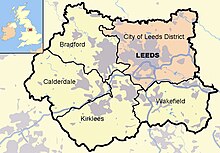

The City of Leeds is the local government district covering Leeds, and the local authority is Leeds City Council. The council is composed of 99 councillors, three for each of the district's wards. Elections are held three years out of four, on the first Thursday of May. One third of the councillors are elected, for a four-year term, in each election. The council is currently controlled by Labour. West Yorkshire does not have a county council, so Leeds City Council is the primary provider of local government services for the city. The district is in the Yorkshire and the Humber region of England.
Most of the district is an unparished area. In the unparished area, there is no lower tier of government. Outside the unparished area, there are 31 civil parishes, represented by parish councils. These are the lowest tier of local government[91] and absorb some limited functions from Leeds City Council in their areas.
The district is represented by eight MPs, for the constituencies of Elmet and Rothwell (Alec Shelbrooke, Conservative); Leeds Central (Hilary Benn, Labour); Leeds East (Richard Burgon, Labour); Leeds North East (Fabian Hamilton, Labour); Leeds North West (Alex Sobel, Labour); Leeds West (Rachel Reeves, Labour); Morley and Outwood (constituency shared with City of Wakefield) (Andrea Jenkyns, Conservative); and Pudsey (Stuart Andrew, Conservative).
Economy[]


Leeds has the most diverse economy of all the UK's main employment centres and has seen the fastest rate of private sector jobs growth of any UK city and has the highest ratio of public to private sector jobs of all the UK's Core Cities. The city had the third-largest jobs total by local authority area with 480,000 in employment and self-employment at the beginning of 2015.[92] 24.7% were in public administration, education and health, 23.9% were in banking, finance and insurance and 21.4% were in distribution, hotels and restaurants. It is in the banking, finance and insurance sectors that Leeds differs most from the financial structure of the region and the nation.[93] There are 130,100 jobs in the city centre, accounting for 31% of all jobs in the wider district. In 2007, 47,500 jobs were in finance and business, 42,300 in public services, and 19,500 in retail and distribution. 43% of finance sector jobs in the district are contained in Leeds city centre and 44% of those employed in the city centre live more than nine kilometres (5.6 miles) away.[94]
In 2011, the financial and services industry in Leeds was worth £2.1 billion, the fifth-largest in the UK, behind London, Edinburgh, Manchester and Birmingham.[95] Tertiary industries such as retail, call centres, offices and media have contributed to a high rate of economic growth. The city also hosts the only subsidiary office of the Bank of England in the UK. In 2012 GVA for the city was recorded at £18.8 billion,[96] with the entire Leeds City Region generating a £56 billion economy.[5]

Key sectors include finance, retail, leisure and the visitor economy, construction, manufacturing and the creative and digital industries.[5] It has one of the most diverse economies of all the UK's main employment centres and has seen the fastest rate of private-sector jobs growth of any UK city. It also has the highest ratio of private to public sector jobs of all the UK's Core Cities, with 77% of its workforce working in the private sector. Leeds has the third-largest jobs total by local authority area, with 480,000 in employment and self-employment at the beginning of 2015.[5] Leeds is ranked as a "High Sufficiency" level city by the Globalization and World Cities Research Network.[97] Today, Leeds has become the largest legal and financial centre outside London,[5][98] with the financial and insurance services industry worth £13 billion to the city's economy.
Office developments, also traditionally located in the inner area, have expanded south of the River Aire and total 11,000,000 square feet (1,000,000 m2) of space.[94] In the period from 1999 to 2008 £2.5bn of property development was undertaken in central Leeds; of which £711m has been offices, £265m retail, £389m leisure and £794m housing.
The city saw several firsts, including the oldest-surviving film in existence, Roundhay Garden Scene (1888), and the 1767 invention of soda water.[99][100]
Major companies based in the city include William Hill, Channel 4, International Personal Finance, Asda, Leeds Building Society and Northern Foods. Capita Group, KPMG, Direct Line, Aviva, Yorkshire Building Society, BT Group, Telefónica Europe () and TD Waterhouse all also have a considerable presence in the city.[101] In addition to other national governmental offices, the city is home to a large Department for Work and Pensions office building located in Quarry Hill, notable[according to whom?] for its imposing design.[citation needed]
Finance[]
Leeds is the largest centre outside London for financial and business services. Over the next ten years,[when?] the economy is forecast to grow by 25% with financial and business services set to generate over half of GVA growth over that period with Finance and business services accounting for 38% of total output.
The finance and business service sector account for 38% of total output[5][102][95] with more than 30 national and international banks located in the city, including an office of the Bank of England.[98] Leeds is also the UK's third-largest manufacturing centre with around 1,800 firms and 39,000 employees; Leeds manufacturing firms account for 8.8% of total employment in the city and is worth over £7 billion to the local economy.[102] The largest sub-sectors are engineering, printing and publishing, food and drink, chemicals and medical technology.[103]
Leeds has over 30 national and international banks, many of whose northern or regional offices are based in the city. It is the headquarters for First Direct and Yorkshire Bank, and has large Barclays, HSBC, Lloyds Banking Group, NatWest Group and Santander operations.[101]
The city is also an important centre for equity, venture and risk finance. The venture capital provider, YFM Equity Partners, founded in Leeds, is now the UK's largest provider of risk capital to small and medium-sized enterprises.[101]
Law[]
There are around 150 law firms operating in Leeds, employing over 6,700 people. According to The UK Legal 500, "Leeds has a sophisticated and highly competitive legal market, second only to London."[104]
Specialist legal expertise to be found in Leeds includes corporate finance, corporate restructuring and insolvency, global project financing, trade and investment, commercial litigation, competition, construction, Private Finance Initiatives and Public Private Partnerships, tax, derivatives, IT, employment, pensions, intellectual property, sport and entertainment.[104]
The establishment of an Administrative Court in Leeds in April 2009 reinforced Leeds's position as one of the UK's key legal centres. The court previously sat only in London.[104]
Manufacturing[]
Leeds is the UK's third-largest manufacturing centre and 50% of the UK's manufacturing base is within a two-hour drive of Leeds. With around 1,800 firms and 39,000 employees, Leeds manufacturing firms account for 8.8% of total employment in the city. The largest sub-sectors are engineering, printing and publishing, food and drink, chemicals and medical technology.[103]
Manufacturing and distribution accounted for £26m of new property development in the period.[when?]
Graphics and gaming[]
There is an established creative industry in the city, particularly in the digital gaming sector. A number of large developers have studios in and around the city, including Activision, developers of the mobile versions of the Call of Duty series,[105] and Rockstar Leeds, developers of the Grand Theft Auto series. In 2009 Leeds was the first city outside London to host the Eurogamer Expo.
Leisure and tourism[]

Tourism is important to the Leeds economy, in 2009 Leeds was the eighth-most visited city in England by UK visitors.[106] and the 13th-most visited city by overseas visitors.[107] Research by VisitEngland reported that the day visitor market to Leeds attracts 24.9 million people each year, worth over £654 million to the local economy.[108] In the 2017 Condé Nast Traveler survey of readers, Leeds rated 6th among The 15 Best Cities in the UK for visitors.[109]
In 2016, Leeds received 27.29 million leisure tourist visits generating over £1.6bn for the city, according to data from a STEAM survey. That was a 15.9% increase in revenue over 2015. A 9.7% increase in visits had been recorded since 2013.[110] The industry supported over 19,000 full-time equivalent jobs in 2016.[111]
Public sector[]

In Leeds, 108,000 people work in the public sector—24% of the workforce. The largest employers are Leeds City Council, with 33,000 staff, and the Leeds Teaching Hospitals NHS Trust, with 14,000 staff.[112]
Leeds has become a hub of public-sector health bodies. The Department of Health and Social Care (DHSC), NHS England, the Care Quality Commission, NHS Digital, and Public Health England all have large offices in Leeds. Europe's largest teaching hospital is also based in Leeds, and is home to the Yorkshire Cancer Centre, the largest of its kind in Europe.[113]
Key government departments and organisations in Leeds include the Department for Work and Pensions, with over 3,000 staff, the DHSC, with over 800 staff, HM Revenue and Customs with over 1,200 staff and the British Library with 1,100 staff.[112]
Shopping[]

The extensive retail area of Leeds is identified as the principal regional shopping centre for the whole of the Yorkshire and the Humber region with a catchment of 5.5 million people offering a spend of £1.93 billion annually.[114] There are a number of indoor shopping centres in the centre of the city, including the Merrion Centre, St John's Centre, The Core, the Victoria Quarter, The Light, the Corn Exchange, Trinity Leeds, and Victoria Gate.[115] In total there are well over 1,000 retail stores, with a combined floorspace of 3,660,000 square feet (340,000 m2).[94] in Leeds City Centre. The city centre has a large pedestrian zone. Briggate is the main shopping street where one can find many well-known British High Street stores, including Marks & Spencer, House of Fraser, Debenhams, Topshop, Costa Coffee and Harvey Nichols. Many companies have several stores within Central Leeds and the wider city.
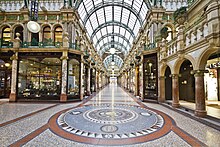
The Victoria Quarter is notable for its high-end luxury retailers and impressive architecture. 70 stores such as Louis Vuitton, Vivienne Westwood, Paul Smith, Diesel and anchor Harvey Nichols are contained within two iron-wrought Victorian arcades, and a new arcade formed by arcading Queen Victoria Street with the largest expanse of stained glass in Britain.[116][117]
In the Churwell area of Leeds is the White Rose Shopping Centre. Opening in 1997, the centre has over 100 high street stores anchored by Debenhams, Marks & Spencer, Primark and Sainsbury's. Some stores have their only Leeds presence here and do not trade in Central Leeds, such as the Disney Store and Build-A-Bear workshop. Although the centre is below the average typical size for out of town shopping malls like the Trafford Centre or nearby Meadowhall in Sheffield, it remains popular with national and international chains. Of the 40,000 people who work in retailing in Leeds 75% work in places which are not located in the city centre. There are additional shopping centres located in the many villages that became part of the county borough and in the towns that were incorporated in the City of Leeds in 1974.[118]
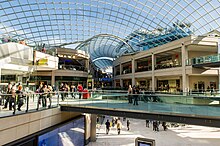
On 21 March 2013, a large shopping and leisure complex called Trinity Leeds opened in the city centre. The modern and interactive retail space covers the old Burton Arcades and the former Leeds Shopping Plaza with its main entrance from Briggate.[119]

On 20 October 2016, the newest shopping destination called Victoria Gate opened its doors to the public. The new shopping mall houses a flagship John Lewis store, the largest outside London. Seventy-five per cent of the stores that opened in Victoria Gate were new to Leeds with many of those stores being the first outside of London.[120]
The Springs, located to the east of the city, just off junction 46 of the M1.[121]
Markets[]
Leeds is home to one of the largest indoor markets in Europe,[122] Leeds Kirkgate Market. Leeds also has various regular local markets in Otley, Pudsey, and Yeadon.[123]
There is an annual German Christmas Market ("Christkindelmarkt") based in Millennium Square, usually running from early November to mid-late December.[124] The 2020 Christmas Market was cancelled because of the coronavirus pandemic.[125]
Landmarks[]

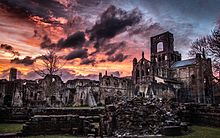
Leeds displays a variety of natural and built landmarks. Natural landmarks include such diverse sites as the gritstone outcrop of Otley Chevin and the Fairburn Ings RSPB reserve. The city's parks at Roundhay and Temple Newsam have long been owned and maintained by the council for the benefit of ratepayers and among the open spaces in the centre of Leeds are Millennium Square, City Square, Park Square and Victoria Gardens. This last is the site of the central city war memorial: there are 42 other war memorials in the suburbs, towns and villages in the district.[126]
The built environment embraces edifices of civic pride like Morley Town Hall and the trio of buildings in Leeds, Leeds Town Hall, Corn Exchange and Leeds City Museum by the architect Cuthbert Brodrick. The two white buildings on the Leeds skyline are the Parkinson building of Leeds University and the Civic Hall, with golden owls adorning the tops of the latter's twin spires.[127]
Armley Mills, Tower Works, with its campanile-inspired towers, and the Egyptian-style Temple Works hark back to the city's industrial past, while the site and ruins of Kirkstall Abbey display the beauty and grandeur of Cistercian architecture. Notable churches are Leeds Minster (formerly Leeds Parish Church), St George's Church and Leeds Cathedral, in the city centre, and the Church of St John the Baptist, Adel and Bardsey Parish Church in quieter locations. Notable non-conformist chapels include the Salem Chapel, dating back to 1791 and notably the birthplace of Leeds United Football Club in 1919.[128][129]
Leeds is one of only a few UK cities outside of London to have a significant number of high-rise buildings, the 112-metre (367 ft) tower of Bridgewater Place, also known as The Dalek, is part of a major office and residential development and the region's tallest building; it can be seen for miles (kilometres) around.[130] Bridgewater Place has been the subject of debate as its erection in 2007 caused significant wind tunnel effects, channeling strong wind currents across Victoria Road. There have been numerous injuries attributed to the inadequate architecture of this building[131] and Water Lane is frequently closed when high winds are expected. In 2017 Leeds City Council undertook construction work in an attempt to deflect the wind from street level and the building owners of Bridgewater Place agreed to pay to cover the public money being spent.[132][133] Among other Skyscrapers the 37-storey Sky Plaza to the north of the city centre stands on higher ground so that its 106 metres (348 ft) is higher than Bridgewater Place.
Elland Road (football) and Headingley Stadium (cricket and rugby) are well known to sports enthusiasts[citation needed] and the White Rose Centre is a well-known retail outlet[citation needed].

Transport[]
Leeds' transport system is dominated by cars and it is currently the 9th most congested UK city, with congestion costing £1,057 per driver.[134]
There have long been plans for a public transport network in Leeds, yet as of 2020, none have come to fruition. In the 1940s, there were plans to build an extensive underground system, however these were scuppered by the Second World War.[135] There were plans for a Leeds Supertram in the 1990s and £500 million in funding was to be provided; however, due to spiralling costs, the plans were cancelled by the Transport Minister Alistair Darling in 2005, even though £40 million had already been spent on the project. Hopes were renewed with the proposal for a £250 million New Generation Transport Trolleybus service in 2007; however, after a long wait and millions of pounds spent on inquiries, the plans were cancelled in May 2016 citing little value for money.[136]
In June 2019, as part of his bid to become Prime Minister, Boris Johnson stated that it was "madness" that Leeds did not have a metro system.[137] In December 2019, during his first Queen's Speech, Johnson promised to "remedy the scandal that Leeds is the largest city in Western Europe without light rail or a metro".[138]
Roads[]

Leeds is the starting point of the A62, A63, A64, A65, A647 and A660 roads, and is also situated on the A58 and A61. The M1 and M62 intersect to its south and the A1(M) passes to the east. Leeds is one of the principal hubs of the northern motorway network. Additionally, there is an urban motorway network; the radial M621 takes traffic into central Leeds from the M62 and M1. There is an Inner Ring Road with part motorway status and an Outer Ring Road. Part of the city centre[139] is pedestrianised, and is encircled by the clockwise-only Loop Road.
Construction of a major new road in the north east of the city, the East Leeds Orbital Route (ELOR), commenced in summer 2019 with completion due by the end of 2021.[140] During the design and construction of the new road, the project partners, Leeds City Council, West Yorkshire Combined Authority and the Highways Agency,[141] are aiming to secure additional social value benefits including aiming for a minimum of 75% of the costs being spent with local suppliers and SME, 2% with local social enterprises spend and 0.5% with female, black and minority ethnic (BAME) or ex-military personnel owned suppliers. Targets at phase 3 of the project (the main construction phase) also include a minimum of 60% local labour, 26 new starters, 16 apprentices, 20 schools engaged, 100+ volunteer days, one charitable event per year and a minimum Considerate Constructors score of 45/50.[142] Balfour Beatty are the lead contractor.[143]
Clean Air Charging Zone[]


Air quality in Leeds has been declared as being "unsafe" by the World Health Organization. Neville Street, near Leeds railway station, has been measured as the most polluted outside London.[144]
As part of plans to tackle illegal levels of air pollution,[145] there are plans to create a Clean Air Zone in Leeds City Centre and parts of north Leeds, wherein drivers will be charged a daily fee for driving "older models of buses, taxis and HGVs" in these areas. The clean air zone was originally proposed in 2018 after government ordered the council to come up with ways to lower the air pollution in the city, which causes around 29,000 premature deaths in the UK.[146] This was intended to begin in January 2020, but was delayed until summer 2020 and then September 2020 owing to delays in the availability of a government vehicle registration tool.[147] This was further delayed by the Coronavirus pandemic until "at least" 2021,[148] before being cancelled altogether in October 2020 due to improvements in the city's air quality.[149]
Buses[]

Public transport in the Leeds area is coordinated and developed by West Yorkshire Metro,[150] with service information provided by Leeds City Council[151] and West Yorkshire Metro. The primary means of public transport in Leeds are the bus services. The main provider is First Leeds and Arriva Yorkshire serves routes to the south of the city. Leeds City bus station is at Dyer Street and is used by bus services to towns and cities in Yorkshire, plus a small number of local services. Adjacent to it is the coach station for National Express coach services. Buses out of the city are mainly provided by First Leeds and Arriva Yorkshire. Harrogate Bus Company provides a service to Harrogate and Ripon. Keighley Bus Company provides a service to Shipley, Bingley and Keighley. The Yorkshire Coastliner service runs from Leeds to Bridlington, Filey, Scarborough and Whitby via York and Malton. Stagecoach in Hull provides a service to Hull via Goole. Stagecoach Yorkshire provides services to Barnsley. Also Transdev operates Flyer services to Leeds Bradford Airport.
Rail[]
Leeds currently has the third busiest railway station,[152] outside London. From Leeds railway station at New Station Street, West Yorkshire Metro trains operated by Northern run to Leeds' suburbs and onwards to all parts of Leeds City Region. The station is one of the busiest in England outside London, with over 900 trains and 50,000 passengers passing through every day.[153] It provides national and international connections, as well as services to local and regional destinations. The station itself has 17 platforms, making it the largest in England outside London.[154]
The city and metropolitan borough of Leeds is served by 16 railway stations. Plans for a parkway station serving Leeds Bradford Airport and two other new stations within the next 20 years were announced in 2016.[155]
Leeds has a less extensive public transport coverage than other UK cities of comparable size, and is the largest city in Europe without any form of light rail or underground system.[156]
High Speed 2 Phase Two was planned to connect Leeds to London via East Midlands Hub and Sheffield, but the Leeds arm was scrapped in November 2021.
Air[]
Leeds Bradford International Airport is located in Yeadon, about 8 miles (13 km) to the north-west of the city centre, and has direct flights from 8 UK destinations and 70 international destinations. The airport is the tenth busiest airport outside London,[157] with scheduled services running to London Heathrow, Amsterdam, Dublin and Barcelona. There is also a direct rail service from Leeds to Manchester Airport.[158]
Recreation[]
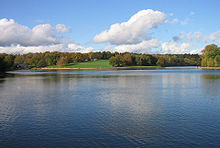
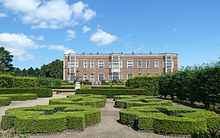
Walking[]
The Leeds Country Way is a waymarked circular walk of 62 miles (100 km) through the rural outskirts of the city, never more than 7 miles (11 km) from City Square. The Meanwood Valley Trail leads from Woodhouse Moor along Meanwood Beck to Golden Acre Park. The Leeds extension of the Dales Way follows the Meanwood Valley Trail before it branches off to head towards Ilkley and Windermere. Leeds is on the northern section of the Trans Pennine Trail for walkers and cyclists, and the towpath of the Leeds and Liverpool Canal is another popular walking and cycling route. The White Rose Way walking trail to Scarborough begins at City Square. In addition, there are many parks and public footpaths in both the urban and rural parts of Leeds, and The Ramblers' Association, YHA and other walking organisations offer sociable walks. The Ramblers' Association publish various booklets of walks in and around Leeds.[159]
Parks and open spaces[]
Leeds has many large parks and open spaces. Roundhay Park is the largest park in the city and is one of the largest city parks in Europe. The park has more than 700 acres (2.8 km2)[160] of parkland, lakes, woodland and gardens which are all owned by Leeds City Council. Other parks in the city include: Beckett Park, Bramley Fall Park, Cross Flatts Park, East End Park, Golden Acre Park, Gotts Park,[161] the gardens and grounds of Harewood House, Horforth Hall Park, Meanwood Park, Middleton Park, Potternewton Park, Pudsey Park,[162] Temple Newsam, Western Flatts Park and Woodhouse Moor. There are many more smaller parks and open spaces scattered around the city, which make up around 21.7% of the city's total area. A 2017 survey ranked Leeds 7th among the ten largest UK cities (by population) for the amount of green space, although published comments on the survey pointed out major inconsistencies in the city boundaries used.[163]
As part of the South Bank regeneration project, plans are in development for Aire Park, a new 3.5 hectare city centre park located close to the former Tetley Brewery site.[164] Planning permission for the first phase to be undertaken by Vastint UK was granted in December 2018.[165]
Education[]
Schools[]
At the time of the 2001 census Leeds had a population of 183,000 young people aged 0–19 of whom 110,000 were attending local authority schools.[166] In 2008 Education Leeds, a non-profit company owned by Leeds City Council, provided for 220 primary schools, 39 secondary schools and 6 special inclusive learning centres.[167] Under the government Building Schools for the Future initiative, Leeds secured £260m to transform 13 secondary schools into high achieving, e-confident, inclusive schools. The first three of these schools at Allerton High School, Pudsey Grangefield School and Rodillian School were opened in September 2008.[168] The demand for primary school places in Leeds has recently hit a 15-year peak, with an estimated 10,500 new starters this year.[169] The city's oldest and largest private school is the Grammar School at Leeds, which was legally re-created in 2005 following the merger of Leeds Grammar School, established 1552, and Leeds Girls' High School, established 1876. Other independent schools in Leeds include faith schools serving the Jewish[170] and Muslim[171] communities.
Leeds was one of a number of local authorities to try the three-tier system with first, middle and secondary schools. It reverted to the two-tier system in 1992.
Further and higher education[]

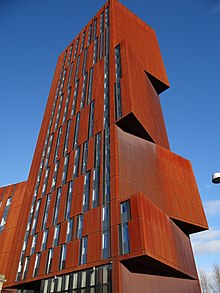
Further education in Leeds is provided by Elliott Hudson College, Leeds City College (formed by a merger in 2009 and having over 60,000 students), Leeds College of Building, University Technical College (UTC) Leeds, and Notre Dame Catholic Sixth Form College.
The city is served by five universities, has the UK's fourth-largest student population and the country's fourth-largest urban economy.[172] Institutions providing higher education include:
- The University of Leeds, which received its charter in 1904 having developed from the Yorkshire College which was founded in 1874 and the Leeds School of Medicine of 1831;
- Leeds Beckett University, formerly Leeds Polytechnic, which became a university in 1992 as Leeds Metropolitan University, and can trace its roots to the Mechanics' Institute of 1824;
- Leeds Trinity University, which began in 1966 as two teacher training colleges which merged in 1980 to form Trinity and All Saints College and became a university in 2012;
- Leeds Arts University, formerly Leeds College of Art, which was founded in 1846 as the Leeds School of Art, and became a university in 2017;
- The University of Law, formerly the College of Law, which became a university in 2012 and moved to its current Leeds centre campus from York in 2014;
- Leeds Conservatoire;
- Northern School of Contemporary Dance;
- University Centre Leeds, part of Leeds City College.[173]
The University of Leeds has about 31,000 students, of which 21,500 are full-time or sandwich undergraduate degree students,[174] Leeds Beckett University has 25,805[175] students of which 12,000 are full-time or sandwich undergraduate degree students and 2,100 full-time or sandwich HND students.[176] Leeds Trinity University has just under 3,000 students.[177] The city was voted the Best UK University Destination by a survey in The Independent newspaper.[178]
Culture[]
In 2018, Leeds embarked on a five-year cultural investment programme, culminating in a year of cultural celebration in 2023. In 2023 the city will hold an international cultural festival which will harness the energy, creativity and momentum of the bid to be European Capital of Culture 2023, from which Leeds and other candidate UK cities were disqualified following the United Kingdom's vote to leave the European Union.[179]
Art[]
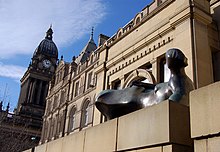
Although the city's municipal art gallery (Leeds Art Gallery) did not open until 1888, art practice and collecting has a long history in Leeds. J. M. W. Turner painted numerous scenes in and around the city,[180] and the city was home to one of Britain's largest collections of Pre-Raphaelite Art, owned by Thomas Plint, during the nineteenth century.[181] There was also an early history of holding large-scale public exhibitions in the city, most notably the series of 'Polytechnic Exhibitions' held regularly from 1839.[182]
Leeds produced many notable artists and sculptors, including Kenneth Armitage, John Atkinson Grimshaw, Jacob Kramer, Barbara Hepworth, Henry Moore, Edward Wadsworth and Joash Woodrow, and was the centre for a particularly radical strain of British art. Before the First World War Leeds was the home of an unusual modernist arts organisation, called the Leeds Arts Club, founded by Alfred Orage, which lasted from 1903 to 1923. Notable members included Jacob Kramer, Herbert Read, Frank Rutter and Michael Sadler. As well as advocating a radical political agenda, supporting the Suffragettes, the Independent Labour Party and the Fabian Society, and promoting the philosophy of Friedrich Nietzsche, the Leeds Arts Club was almost unique in Britain as being an exponent of German Expressionist ideas about art and culture. As a result, it staged very early British exhibitions of work by European expressionist artists, such as Wassily Kandinsky, showing their work in the city as early as 1913,[183] and produced its own English Expressionist artists, including Jacob Kramer and Bruce Turner.[184]
In the 1920s Leeds College of Art was the starting point for the careers of the sculptors Barbara Hepworth and Henry Moore, and in the 1950s, and 1960s it was one of the leading centres for radical art education in Britain under the guidance of artists such as Harry Thubron and Tom Hudson, and the art historian Norbert Lynton. Their attempts to redefine what art education should mean in the post-Second World War period led the artist Patrick Heron to claim in 1971 in The Guardian newspaper that "Leeds is the most influential art school in Europe since the Bauhaus".[185] This willingness to push at the boundaries of acceptable public behaviour from artists was also evident in 1966 when Leeds College of Art staged an exhibition of paintings by the Cypriot artist Stass Paraskos, who taught at the college, which was raided by the police after allegations of obscenity.[186]
This radicalism continued into the 1970s when the higher education component of Leeds College of Art was split from the college to form the nucleus of the new multidisciplinary Leeds Polytechnic, now called Leeds Beckett University. Performance art had been taught earlier at Leeds College of Art, notably by the Fluxus artist Robin Page during his time as a tutor there in the mid-1960s, but in 1977 a performance art work hit the national news headlines when the students Pete Parkin and Derek Wain used an air pistol to shoot a line up of live budgerigars in front of an audience at Leeds Polytechnic.[187]
The University of Leeds was the alma mater of Herbert Read, one of the leading international theorists of modern art from the mid-twentieth century,[188] and also the teaching base for the Marxist art historian Arnold Hauser from 1951 to 1985.[189] Partly due to Herbert Read's connection with the University, from 1950 to 1970 the University was the host of one of the first artist-in-residence schemes in Britain, using funding from the then owner of Lund Humphries books, Peter Gregory. The Gregory Fellowships, as the residencies were known, were given to painters and sculptors for up to two years to allow them to develop their own work and influence the University in any way they saw fit. Amongst those holding the fellowships were Kenneth Armitage, Reg Butler, Dennis Creffield and Terry Frost and others. Parallel Gregory Fellowships also existed in music and poetry at the University.[190]
Leeds was also a centre for radical feminist art, with one of the first galleries in Britain dedicated to showing the work of women photographers, the Pavilion Gallery, opening in the city in 1983, and the University of Leeds School of Fine Art being a well-known centre for the development of feminist art history, under Griselda Pollock, during the 1980s and 1990s. Possibly as a result of the strength of feminist art in Leeds, in November 1984 an exhibition of ceramics by students and staff at Leeds Polytechnic was attacked by a group of feminist activists who destroyed eight sculptures on display which they deemed to be degrading to women.[191] The University of Leeds's School of Fine Art also specialised in Art & Language conceptual art practice, under Terry Atkinson, again in the 1980s and 1990s.[192]
A major sculpture research centre and gallery, the Henry Moore Institute, is located alongside Leeds Art Gallery in the city centre, and in 2013 a new contemporary art centre, called The Tetley, opened on the site of the former Tetley Brewery to the south of the city centre.
In March 2017, The Times voted Leeds as the number one cultural place to live in Britain. This was ahead of London, Birmingham, St Ives, Stratford-upon-Avon and Cheltenham. The citation notes that Leeds has Opera North, the Northern Ballet, and the Leeds Playhouse amongst many other attractions that ranked it at number one.[193]
Carnivals and festivals[]
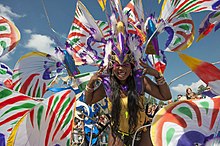
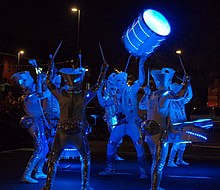
Leeds West Indian Carnival is Western Europe's oldest West Indian Carnival, and the UK's third-largest after the Notting Hill and Nottingham Carnival.[194][195] It attracts around 100,000 people over 2 days to the streets of Chapeltown and Harehills. There is a large procession that finishes at Potternewton Park, where there are stalls, entertainment and refreshments. The Leeds Festival, featuring some of the biggest names in rock and indie music, takes place every year in Bramham Park. The Leeds Asian Festival, formerly the Leeds Mela, is held in Roundhay Park.[196] The Otley Folk Festival (patron: Nic Jones),[197] Walking Festival,[198] Carnival[199] and Victorian Christmas Fayre[200] are annual events. Light Night Leeds takes place each October, and many venues in the city are open to the public for Heritage Open Days in September.[201] The Leeds International Pianoforte Competition, established in 1963 by Fanny Waterman and Marion Stein, has been held in the city every three years since 1963 and has launched the careers of many major concert pianists. The Leeds International Concert Season, which includes orchestral and choral concerts in Leeds Town Hall and other events, is the largest local authority music programme in the UK.[202]
The Leeds International Film Festival is the largest film festival in England outside London[203] and shows films from around the world. It incorporates the highly successful Leeds Young People's Film Festival, which features exciting and innovative films made both for and by children and young people.[204] Garforth is host to the fortnight-long festival The Garforth Arts Festival which has been an annual event since 2005. The Chapel Allerton Arts Festival is a week-long music and arts event starting in 1998 and held the week after August Bank Holiday each year.[205] The Leeds Festival Fringe is a week long-music festival created in 2010 to showcase local talent in the week prior to Leeds Festival.
Light Night, one of the UK's largest annual arts and light festivals, is a huge fixture on the calendar, taking place in the first week of October, turning the entire city into an art installation with light shows, projections, installations and lots more.[206]
Leeds Pride is an annual LGBT+ festival held since 2006 supported by the city council and local business.[207] In 2018 attendance was 40,000[208] with over 100 floats and benefits the city by over £3.8 million.[208][209][210] The city has a sponsorship scheme for its 15 Rainbow Plaques commemorating places and events that are of significance to the LGBT+ community organised through Leeds Civic Trust.[211]
Other festivals include Transform and Thought Bubble.
Cinema[]
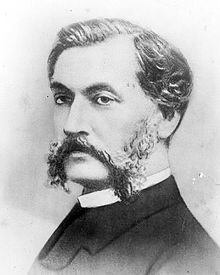
In October 1888 Louis Le Prince filmed moving picture sequences Roundhay Garden Scene and a Leeds Bridge street scene using his single-lens camera and Eastman's paper film.[212] These were several years before the work of competing inventors such as Auguste and Louis Lumière and Thomas Edison. Today, Leeds International Film Festival's International Short Film Competition is named after Louis Le Prince.[213] The 2015 documentary film The First Film, which first aired at the Edinburgh International Film Festival, documents Le Prince's pioneering status.[214]
Wordsworth Donisthorpe who was also from Leeds, filmed the second-oldest-surviving film. It is not known if he and Louis Le Prince ever met but they both had a strong connection to the Leeds Philosophical and Literary Society. Donisthorpe's patent for a camera to capture the moving image pre dated Le Prince's by twelve years.[citation needed]
Leeds has a rich film exhibition culture. In addition to the Leeds International Film Festival and Leeds Young Film Festival, the city hosts numerous independent cinemas and pop-up venues for film screenings.[215] The Cottage Road Cinema and Hyde Park Picture House have continuously been showing films since 1912 and 1914, respectively, which ranks them among the oldest still-running cinemas in the UK.[216]
Literature[]
Leeds has produced many writers of note, including celebrated author and playwright Alan Bennett. J. R. R. Tolkien, author of The Lord of the Rings, lived and taught in Leeds from 1921 to 1925.[217]
Leeds Central Library, the city's public library is located on Calverley Street, near many of Leeds' other municipal buildings.[218] The Leeds Library in Commercial Street is a private subscription library, and the oldest surviving library of this kind in the UK.[219] The British Library houses a significant portion of its collection just outside Boston Spa, a village within the City of Leeds. The Boston Spa location is home to the library's newspaper archive, which contains over 20 million items.[220] The library also plans to open a facility in Leeds City Centre, potentially in the Grade I listed Temple Works in the South Bank area.[221]
In 2019 and 2020, Leeds hosted the Leeds Lit Fest, a "non-traditional" literature festival, incorporating talks, panels & workshops.[222]
There are plans to create a National Poetry Centre in Leeds.[223]
Museums[]

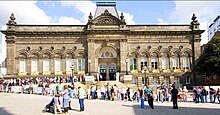

Leeds has over 16 museums and galleries including 9 that are council-run.
A new Leeds City Museum opened in 2008[224] in Millennium Square. Leeds's major museum, it showcases the city's designated collections of local history, world cultures, natural history, archaeology and fine and decorative arts plus a diverse programme of special exhibitions.
Abbey House Museum is housed in the former gatehouse of Kirkstall Abbey, and includes walk-through Victorian streets and galleries describing the history of the abbey, childhood, and Victorian Leeds.
Armley Mills Industrial Museum is housed in what was once the world's largest woollen mill,[225] and includes industrial machinery and railway locomotives. This museum also shows the first known moving pictures in the world which were taken in the city, by Louis Le Prince, of a Roundhay Garden Scene and of Leeds Bridge in 1888. These short film clips can be found on YouTube.
Thwaite Mills Watermill Museum is a fully restored 1820s water-powered mill on the River Aire to the east of the city centre.
The Thackray Museum is a museum of the history of medicine, featuring topics such as Victorian public health, pre-anaesthesia surgery, and safety in childbirth. It is housed in a former workhouse next to St James's Hospital.
The Royal Armouries Museum, the United Kingdom's national collection of arms and armour, opened in 1996 in a dramatic modern building when this part of the collection was transferred from the Tower of London. It is located a short distance from the city centre at Leeds Dock.
Nearby is the Leeds Museum Discovery Centre (formerly housed at the Leeds Museum Resource Centre in Yeadon),[226] the major storage of items not currently on display in museums, and open to the public by appointment.[226][227]
Leeds Art Gallery houses important collections of traditional and contemporary British art, with the best twentieth century collection outside London and a colourful wall painting for the Victorian staircase by Lothar Götz.[228] Just next door, The Henry Moore Institute is dedicated to celebrating sculpture. In the iconic building, they host a year-round changing programme of historical, modern and contemporary exhibitions presenting sculpture from across the world. Located in the striking art deco headquarters of the former brewery, The Tetley is a centre for contemporary art, centred on creativity, innovation and experimentation.
Smaller museums in Leeds include Otley Museum; Horsforth Village Museum;[229] ULITA, an Archive of International Textiles;[230] and the museum at Fulneck Moravian Settlement.
Music, theatre and dance[]
Leeds is home to the refurbished Grand Theatre where the only national opera company outside London, Opera North, is based.[231] The City Varieties Music Hall is one of the UK's few remaining music halls, and famously hosted performances by Charlie Chaplin and Harry Houdini. It was also the venue of the BBC television programme The Good Old Days. The newest theatre, containing two auditoriums, is the Leeds Playhouse, which had formerly been known as the West Yorkshire Playhouse.[232][233][234] Just south of Leeds Bridge once stood The Theatre which hosted Sarah Siddons and Ching Lau Lauro in 1786 and 1834, respectively.[235][236]
Leeds is also home to Phoenix Dance Theatre, who were formed in the Harehills area of the city in 1981, and Northern Ballet Theatre.[237] In autumn 2010 the two companies moved into a purpose-built dance centre which is the largest space for dance outside London. It is also the only space for dance to house a national classical and a national contemporary dance company alongside each another.[238]
The First Direct Arena[239] opened in September 2013. The 13,500-seater stadium is rapidly becoming the city's number one venue for live music, indoor sports and many other events. Concerts are also held at the O2 Academy, Elland Road, which has hosted groups such as Queen and Kaiser Chiefs, among others and at the universities. Roundhay Park in north Leeds has seen some of the world's biggest artists including Michael Jackson, Madonna, Bruce Springsteen and Robbie Williams.
Popular musical acts originating from Leeds include Soft Cell, Kaiser Chiefs, The Pigeon Detectives, The Wedding Present, The Sunshine Underground, The Sisters of Mercy, Hadouken!, Corinne Bailey Rae, Dinosaur Pile-Up, Pulled Apart by Horses, Gang of Four, Hood, The Rhythm Sisters, Utah Saints, Alt-J and Melanie B of the Spice Girls.[240][241][242][243][244][245]
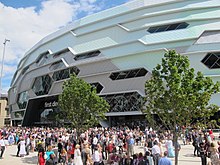
On Valentine's Day 1970, The Who performed and recorded their album Live at Leeds at the University of Leeds Refectory. Since its initial reception, Live at Leeds has been cited by several music critics as the best live rock recording of all time.[246][247][248]
Pink Floyd's popular second single "See Emily Play" was written in Leeds in 1967 after a gig in the old Leeds City College Technology Campus, then known as Kitson College.[249]
Leeds is the only city outside of London to have its own repertory theatre, ballet, and opera companies.[250]
Nightlife[]
Leeds is Purple Flag accredited to indicate an entertaining, diverse, safe and enjoyable night.[251]
Leeds has the fourth largest student population in the country (over 200,000[252]), and is therefore one of the UK's hotspots for night-life. There are a large number of pubs, bars, nightclubs and restaurants, as well as a multitude of venues for live music. The full range of music tastes is catered for in Leeds. It includes the original home of the famous club nights Back 2 Basics, Speedqueen and Vague.[253] Morley was the location of techno club The Orbit.[254] Leeds has a number of large 'super-clubs' and there is a selection of independent clubs such as Club Mission and Mint Club, which is consistently ranked as one of the world's best clubs by DJ Magazine. Two other Leeds clubs, The Warehouse and The Garage, featured in the Top 100 Clubs list from 2013.[255] The Garage has since closed.
The F Club was club night that ran in Leeds between 1977 and 1982 and specialised in punk rock and post-punk.[256][257] It would prove highly influential to the development of the goth subculture, due to it leading to the formation of seminal gothic rock bands like The Sisters of Mercy, The March Violets and Southern Death Cult.[258] The now-defunct club Le Phonographique was located in the Merrion Centre and was the first gothic nightclub in the world.[259][260]
Leeds has a well established LGBT+ nightlife scene, predominantly located in the Freedom Quarter on Lower Briggate.[261] The New Penny is one of the UK's longest running LGBT+ venues, and Leeds oldest gay bar. The Viaduct Showbar holds drag cabaret, live shows and DJs. Other places include The Bridge, Blayds Bar, Tunnel Leeds and Queens Court.
Popular areas for nightlife in Leeds include Call Lane, Briggate and the Arena Quarter. Towards Millennium Square is a growing entertainment district providing for both students and weekend visitors. The square has many bars and restaurants and a large outdoor screen. Millennium Square is a venue for large seasonal events such as a Christmas market, gigs and concerts, and citywide parties. It is adjacent to the Mandela Gardens, which were opened by Nelson Mandela in 2001. A number of public art features, fountains, and greenery can be found here.
Yorkshire has a great history of real ale,[262] but several bars near the railway station are fusing traditional beers with a modern bar. Popular bars such as this include The Hop, The Cross Keys and The Brewery Tap. Leeds also hosts an annual Leeds International Beer Festival, held at Leeds Town Hall every September.
Media[]
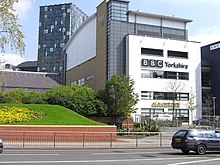
Yorkshire Post Newspapers Ltd, owned by Johnston Press plc, is based in the city, and produces a daily morning broadsheet, The Yorkshire Post, and an evening paper, the Yorkshire Evening Post (YEP). The YEP has a website which includes a series of community pages which focus on specific areas of the city.[263] The Wetherby News covers mainly areas within the north eastern sector of the district, and the Wharfedale & Airedale Observer, published in Ilkley, covers the north-west, both appearing weekly. The two largest universities both have student newspapers, the weekly Leeds Student from the University of Leeds and the monthly The Met from Leeds Beckett University. The Leeds Guide was a fortnightly listings magazine, which was established in 1997 and ceased publication in 2012. Free publications include the Leeds Weekly News, produced by Yorkshire Post Newspapers in four geographic versions and distributed to households in the main urban area of the city,[264] and the regional version of Metro which is distributed on buses and at railway stations.
Regional television and radio stations have bases in the city: BBC Television and ITV both have regional studios and broadcasting centres in Leeds, in addition to Channel 4 having recently[when?] announced that their national HQ will be located in Leeds.[265] ITV Yorkshire, formerly Yorkshire Television, broadcasts from the Leeds Studios on Kirkstall Road. There are a number of independent film production companies, including the not-for-profit cooperative Leeds Animation Workshop, founded in 1978; community video producers Vera Media and several small commercial production companies. BBC Radio Leeds, Pulse 1, Greatest Hits Radio, Capital Yorkshire and Heart Yorkshire broadcast from the city. LSRfm.com, is based in Leeds University Union, and regularly hosts outside broadcasts around the city. Many communities within Leeds now have their own local radio stations, such as East Leeds FM and Tempo FM for Wetherby and the surrounding areas[citation needed].
Leeds has a local television station called Leeds TV which is required to broadcast 37 hours a week of first-run local programming.[266] The station had launched in 2014 as Made in Leeds which launched across the city in 2014.[267] A privately owned television station: Leeds Television is run by volunteers and supported by professionals in the media industry.[citation needed]
Sport[]

The city has teams representing all the major national sports. Leeds United F.C. is the city's main football club, additional clubs include Guiseley AFC and Farsley Celtic. Leeds United was formed in 1919 and plays at the 37,890-capacity Elland Road Stadium in Beeston. The team rejoined the Premier League, following a sixteen-year stint in lower divisions, after they won promotion by winning the EFL Championship in 2019–20. Guiseley was formed in 1909 and plays at the 4,000 capacity Nethermoor Park Stadium in Guiseley. The team plays in the National League North they won promotion to the National League for the first time ever in 2014/15 after beating Chorley 2–3. Farsley Celtic was formed in 1908 and plays in the National League North and their stadium is Throstle Nest.
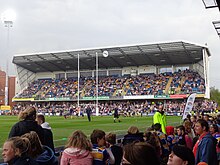
Leeds Rhinos are the most successful rugby league team in Leeds. In 2009, they became first club to be Super League champions three seasons running, giving them their fourth Super League title.[268] They play their home games at the Headingley Rugby Stadium. Hunslet, based at the John Charles Centre for Sport, play in the Co-Operative Championship One. East Leeds and Oulton Raiders play in the National Conference League. Bramley Buffaloes (previously Bramley), and Leeds Akkies were members of the Rugby League Conference.
Leeds Tykes are the foremost rugby union team in Leeds and they previously also played at Headingley. They play in National League 1 having been relegated from RFU Championship at the end of the 2019–20 season. Otley RUFC are a rugby union club based to the north of the city and compete in National League 2 North, whilst Morley RFC, located in Morley currently play in National Division Three North.
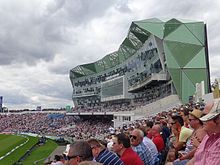
Headingley Cricket Stadium is home to Yorkshire County Cricket Club which is the most successful cricket team in England, with 33 County Championship wins (including one shared). Their main rivals are Lancashire.
Leeds City Athletic Club competes in the British Athletics League and UK Women's League as well as the Northern Athletics League.
Leeds is home to a number of field hockey clubs that compete in the North Hockey League, Yorkshire Hockey Association League and BUCS leagues. These include Leeds Hockey Club, Leeds Adel Carnegie Hockey Club, the University of Leeds Hockey Club and Leeds Beckett University Hockey Club.[269][270][271][272][273] Leeds Hockey Club Men's 1s gained promotion at the end of the 2016/2017 season to become Leeds's first hockey team competing in a National League.[274]
The City of Leeds Synchronised Swimming Club[275] train at the John Charles Centre for Sport and are represented by swimmers throughout the whole of the North East. The club was founded in 2008 and only compete in National and International Competition.
The city has a wealth of sports facilities including the Elland Road football stadium, a host stadium during the 1996 European Football Championship; the Headingley Carnegie Stadiums, adjacent stadia world-famous for both cricket and rugby league and the John Charles Centre for Sport with an Olympic-sized pool in its Aquatics Centre[276] and includes a multi-use stadium. Other facilities include the Leeds Wall (climbing) and Yeadon Tarn sailing centre. In 1929 the first Ryder Cup of Golf to be held on British soil was competed for at the Moortown Golf club in Leeds and Wetherby has a National Hunt racecourse.[277] In the period 1928 to 1939 speedway racing was staged in Leeds on a track at the greyhound stadium known as Fullerton Park, adjacent to Elland Road. The track entered a team in the 1931 Northern league.
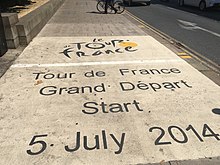
The 2014 Tour de France Grand Départ took place from the Headrow in Leeds city centre on 5 July 2014.
Leeds is well known for its divers and features some of the best diving facilities in the UK. City of Leeds Diving Club, who train at the John Charles Centre for Sport, has trained many athletes who have competed at international and Olympic level, with Jack Laugher and Chris Mears making history by becoming the first ever divers from Great Britain to win an Olympic gold medal, a feat they accomplished at the 2016 Rio Olympics.
Leeds has an ice hockey team, the Leeds Chiefs; they play at the Planet Ice Arena in Beeston, Leeds in the National Ice Hockey League.
Teams[]
| Club | Sport | League | Venue | Location | Formed | Top flight championships |
|---|---|---|---|---|---|---|
| Yorkshire CCC | Cricket | County Championship | Headingley Stadium | Headingley | 1863 | 33 |
| Leeds Rhinos | Rugby league | Super League | Headingley Stadium | Headingley | 1870 | 11 |
| Leeds United | Football | English Premier League | Elland Road Stadium | Beeston | 1919 | 3 |
| Hunslet | Rugby league | League 1 | John Charles Centre for Sport | Hunslet | 1883 | 2 |
| Leeds Tykes | Rugby union | National League 1 | The Sycamores | Bramhope | 1991 | 0 |
| Guiseley | Football | National League North | Nethermoor Park | Guiseley | 1909 | 0 |
| Farsley Celtic | Football | National League North | Throstle Nest Stadium | Farsley | 1908 | 0 |
| Leeds Chiefs | Ice hockey | National Ice Hockey League | Planet Ice Leeds | Beeston | 2019 | 0 |
Religion[]

The majority of people in Leeds identify themselves as Christian.[86] Leeds does not have a Church of England Cathedral: it is in the Anglican Diocese of Leeds (formerly in the Diocese of Ripon and Leeds), headed by the Bishop of Leeds, which has cathedrals in Bradford, Ripon and Wakefield although the Bishop's residence has been in Leeds since 2008. The most important Anglican church is Leeds Minster, although St. George's has the largest congregation by far.[citation needed] Leeds has a Roman Catholic Cathedral, the episcopal seat of the Roman Catholic Diocese of Leeds. Many other Christian denominations and new religious movements are established in Leeds, including Assemblies of God, Baptist, Christian Scientist, Latter-day Saints ("LDS" or "Mormon"), Community of Christ, Greek Orthodox, Jehovah's Witnesses, Jesus Army, Lutheran, Methodist, Moravian, Nazarene, Newfrontiers, Pentecostal, Salvation Army, Seventh-day Adventist, Society of Friends ("Quakers"), Unitarian, United Reformed, Vineyard, an ecumenical Chinese church, Winners' Chapel and several independent churches.[278][279]


The proportion of Muslims in Leeds is slightly above average for the country (5.4% as of 2011).[86] Mosques can be found throughout the city, serving Muslim communities in Chapeltown, Harehills, Hyde Park and parts of Beeston. The largest mosque is Leeds Grand Mosque in Hyde Park.
The Sikh community is represented by gurdwaras (temples) spread across the city, the largest being in Chapeltown. There is also a colourful religious annual procession, called the Nagar Kirtan, into Millennium Square in the city centre on 13–14 April to celebrate Vaisakhi—the Sikh New Year and the birth of the religion. It is estimated that around 3,000 Sikhs in Leeds take part in this annual event.
Leeds's Jewish community is the third-largest in the United Kingdom, after London and Greater Manchester.[280][281] The areas of Alwoodley and Moortown contain sizeable Jewish populations.[87] There are eight active synagogues in Leeds.[282]
The Hindu community in Leeds has a temple (mandir) at Hyde Park.[283] The temple has all the major Hindu deities and is dedicated to the Lord Mahavira of the Jains.[284]
Various Buddhist traditions are represented in Leeds,[285] including: Soka Gakkai[citation needed], Theravada, Tibetan, Triratna Buddhist Community and Zen. The Buddhist community (sangha) comes together to celebrate the major festival of Wesak in May.
There is also a community of the Bahá'í Faith in Leeds.[286]
Public services[]
Water supply and sewerage services in Leeds are provided by Yorkshire Water, part of the Kelda Group. Prior to 1973 water and sewerage services had been provided by the Leeds Corporation. Leeds City Council has a target of 11MW of renewable energy from onshore wind by 2010 and an aspirational target of 75MW by 2020. There are currently no operational wind farms in Leeds, but a planning application by Banks Renewables Ltd for five turbines at Hook Moor near Micklefield was approved in 2011.[287]

The area is policed by the West Yorkshire Police. The force has five policing districts covering the West Yorkshire area, one of which covers Leeds. The Leeds District Headquarters is located at Elland Road in the south of the city. In the north-west of the city the main stations are Weetwood and Woodhouse Lane; in the north-east, the main stations are Stainbeck near Chapel Allerton and Killingbeck; in the south the main stations are Leeds Central, located on Park Street in the city centre, and the District Headquarters itself. Fire and rescue services are provided by the West Yorkshire Fire and Rescue Service. The fire stations in Leeds are: Cookridge, Gipton, Hunslet, Stanks, Moortown, Stanningley and the "Leeds" fire station (near the city centre, on Kirkstall Road).
NHS health services are provided by the Leeds Teaching Hospitals NHS Trust, Leeds Primary Care Trust [288] and Leeds and York Partnership NHS Foundation Trust,[289][290] which provides mental health services. Leeds General Infirmary ("LGI") is a listed building with more recent additions and is in the city centre. St James's University Hospital, known locally as "Jimmy's",[291][292] is to the north east of the city centre and is the largest teaching hospital in Europe. Other NHS hospitals are Chapel Allerton Hospital, Seacroft Hospital, Wharfedale Hospital in Otley, and Leeds Dental Institute. The new NHS Leeds Website provides information on NHS services in Leeds.[293]
West Yorkshire Joint Services provides analytical, archaeological, archives, ecology, materials testing and trading standards services in Leeds and the other four districts of West Yorkshire. It was created following the abolition of the county council in 1986 and expanded in 1997, and is funded by the five district councils, pro rata to their population. The Leeds site of the archives service is in the former public library at Sheepscar, Leeds.[294]
Leeds City Council is responsible for over 50 public libraries across the whole city, including 5 mobile libraries. The main Central Library is located on the Headrow in the city centre.
Freedom of the City[]
The following people and military units have received the Freedom of the City of Leeds.
This list is incomplete; you can help by . (August 2019) |
Individuals[]
- Field Marshal Rt Hon Lord Haig KT GCB OM GCVO KCIE: 23 January 1920.[295]
- Admiral of the Fleet Rt Hon Lord Beatty GCB OM GCVO DSO PC: 18 October 1922.[296]
- Rt Hon David Lloyd George OM PC: 21 October 1922.[297]
- Rt Hon E.F.L. Wood KG OM GCSI GCMG GCIE TD PC: 5 March 1923.[298]
- Stanley Baldwin KG PC PC (Can) JP FRS: 13 March 1925.
- Rt Hon Lord Asquith KG PC KC FRS: 13 March 1925.
- Rt Hon Lord Moynihan KCMG CB FRCS: 6 October 1926.
- Sir William Middlebrook Bt JP: 6 October 1926.
- Sir Edward Brotherton Bt: 6 October 1926.[298]
- Rt Hon Philip Snowden MP PC: 11 September 1930.
- Rt Hon Arthur Greenwood CH MP PC: 11 September 1930.[298][299]
- HRH Princess Royal: 7 July 1932.[300]
- Rt Hon H. V. Evatt QC PC KStJ: 7 July 1943.[301]
- Rt Hon Sir Winston Churchill KG PC (Can) OM CH TD DL FRS RA: 28 October 1958.[302]
- Major Rt Hon Lord Milner of Leeds MC PC: 1967.
- Nelson Mandela: 30 April 2001.[303]
- Dame Fanny Waterman DBE: April 2004.
- Jane Tomlinson CBE: 20 May 2005.[304]
- Alan Bennett: 12 March 2006.
- James Heselden OBE: 26 January 2011.[305] (Awarded Posthumously)
- Beryl Burton OBE: 12 September 2014.[306] (Awarded Posthumously)
- Leeds United FC 1967–74: 4 December 2019.[307]
Military units[]
- HMS Ark Royal, RN: 4 November 1941.[308]
- RAF Church Fenton: 1971.
- HMS Ark Royal, RN: 25 October 1973.[309][310]
- 5th Battalion The Rifles: 1 August 2009.[311]
- 4th Battalion The Parachute Regiment: 9 December 2020.[312]
- Leeds Rifles
- Leeds Pals
- 51st (2nd Yorkshire West Riding) Regiment of Foot
See also[]
- BrassNeck Theatre
- List of people from Leeds
- Leeds (Whitehall Road) power station
Notes and references[]
Citations[]
- ^ Max (City of Leeds) at SE140445 Hawksworth Moor in extreme west of district.
- ^ Min (City of Leeds) at points where district boundary crosses Rivers Aire and Wharfe in extreme east.
- ^ National Statistics: Neighbourhood Statistics. "Ethnicity and National Identity in England and Wales 2011". Archived from the original on 10 January 2013. Retrieved 29 April 2015.
- ^ a b "Global city GDP 2014". Brookings Institution. Archived from the original on 5 June 2013. Retrieved 18 November 2014.
- ^ a b c d e f "Leeds economy". Archived from the original on 18 January 2017.
- ^ "Definition of 'Leeds'". Collins English Dictionary. Archived from the original on 15 December 2018. Retrieved 15 December 2018.
"Leeds Tourism". Planet Ware Travel Guide. Archived from the original on 5 May 2009. Retrieved 1 February 2009.
"Leeds stakes it claim to financial hub". The Yorkshire Post. Retrieved 1 February 2009.
"About Leeds". www.bookinghime.com. Archived from the original on 9 May 2008. Retrieved 1 February 2009. - ^ Burt & Grady 1994, p. 92
- ^ "West Yorkshire BUA". statistics.data.gov.uk. ONS. Retrieved 16 November 2020.
"2011 Census - Nomis - Official Labour Market Statistics". www.nomisweb.co.uk. Archived from the original on 21 September 2013. Retrieved 14 July 2013. - ^ Hanks, Patrick; Hodges, Flavia; Mills, A. D.; Room, Adrian (2002). The Oxford Names Companion. Oxford: the University Press. p. 1104. ISBN 0198605617.
- ^ Fletcher, J. S. (1919). The Story of English Towns: Leeds. London: Society for Promoting Christian Knowledge. OCLC 221589888. Archived from the original on 1 May 2009. Retrieved 22 July 2009.
- ^ "Loiners of the world unite!". BBC. 22 August 2005. Archived from the original on 19 May 2010. Retrieved 27 September 2009.
- ^ "The place-names of England and Wales". Archived from the original on 27 March 2016. Retrieved 17 July 2017.
- ^ Caunce, S.A. (2003). "Houses as Museums: The Case of the Yorkshire Wool Textile Industry". Transactions of the Royal Historical Society. Royal Historical Society. 13: 329–343. doi:10.1017/S0080440103000197. S2CID 111082735.
- ^ Burt & Grady 1994, p. 57
- ^ Fraser 1982, p. 143
- ^ Morris, J. (2002). Atlas of Industrializing Britain, 1780-1914. Routledge. p. 172. ISBN 9781135836450. Archived from the original on 26 February 2019. Retrieved 26 February 2017.
In the 1830s, William Lupton left his widow with land..... in Merrion and Belgrave streets (Briggate)...the enclosed fields of the manor of Leeds were already occupied by a woolen mill and its reservoir and the house and outbuildings of William Lupton - a gentleman merchant
- ^ "Reports of All the Cases Decided by All the Superior Courts Relating to Magistrates, Municipal, and Parochial Law". Law Times Office. 1873. p. 407. Archived from the original on 26 February 2019. Retrieved 26 February 2017.
- ^ COOKSON, GILLIAN (2018). AGE OF MACHINERY : engineering the industrial revolution, 1770-1850. Woodbridge: BOYDELL Press. ISBN 978-1-78744-238-2. OCLC 1020615091.
- ^ Haywood, Russ (2007). "Britain's national railway network: fit for purpose in the 21st century?". Journal of Transport Geography. Elsevier. 15 (3): 198–216. doi:10.1016/j.jtrangeo.2006.02.015.
- ^ a b Fraser 1982, p. 144
- ^ Fraser 1982, p. 155
- ^ Honeyman, Katrina (2000). Well suited: a history of the Leeds clothing industry, 1850–1990. Oxford University Press. ISBN 0-19-920237-0.
- ^ a b Harcup, Tony (2000). "Re-imaging a post-industrial city". City. Carfax. 4 (2). doi:10.1080/13604810050147839. S2CID 143928899.
- ^ "Legal services: Law firms have solid local roots and global ambitions". Financial Times. 11 March 2008. Retrieved 26 September 2009.
- ^ Leeds, Live it, Love it. "Sectors: Retail". Marketing Leeds. Archived from the original on 4 January 2010. Retrieved 26 September 2009.CS1 maint: multiple names: authors list (link)
- ^ "Work begins on Logic Leeds business park". Insider Media. 23 May 2013. Archived from the original on 2 April 2015. Retrieved 12 March 2015.
- ^ Great Britain Historical GIS / University of Portsmouth, Leeds parish population. Retrieved {{{accessdate}}}.
- ^ a b "Relationships / unit history of Leeds". Archived from the original on 14 August 2011. Retrieved 2 February 2017.
- ^ Thornton, David (2021). Leeds: A Biographical Dictionary. Beecroft Publications. p. 6.
- ^ "Briggate: Improvement Acts". Discovering Leeds. Leeds City Council. Archived from the original on 28 November 2011. Retrieved 27 September 2009.
- ^ "Leeds MB/CB". Archived from the original on 13 February 2012. Retrieved 2 February 2017.
- ^ Fraser 1982, p. 459
- ^ "Impact of Urban Development Corporations in Leeds, Bristol & Central Manchester". Department of the Environment, Transport and the Regions. 18 November 1998. Archived from the original on 11 December 2008. Retrieved 25 September 2009.
- ^ Burt & Grady 1994, p. 163
- ^ Fraser 1982, p. 96
- ^ "The Working Classes: Housing". Discovering Leeds. Leeds City Council. Archived from the original on 28 November 2011. Retrieved 26 September 2009.
- ^ a b Fraser 1982, p. 98
- ^ Fraser 1982, p. 57
- ^ Burt & Grady 1994, p. 193
- ^ Unsworth and Stillwell 2004, p. 77
- ^ "Light Shines on Leeds Skyscraper Bids". www.skyscrapernews.com. Archived from the original on 11 February 2010. Retrieved 24 May 2010.
- ^ "Distance from Leeds to London". ukdistance.com. Archived from the original on 18 December 2018. Retrieved 18 December 2018.
- ^ a b c Office for National Statistics (2001). "Census 2001:Key Statistics for urban areas in the North; Map 6" (PDF). United Kingdom Census 2001. statistics.gov.uk. Archived from the original (PDF) on 9 January 2007. Retrieved 27 September 2009.
- ^ "Leeds – the facts". Yorkshire Forward Government agency. Archived from the original on 16 February 2009. Retrieved 22 January 2009.
- ^ "Leeds – The Yorkshire Dales". Visit Britain (National UK Tourist Agency). Archived from the original on 5 December 2008. Retrieved 22 January 2009.
- ^ Kendall, Percy Fry; Wroot, Herbert (1972). Geology of Yorkshire Part II. East Ardsley, Wakefield: EP Publishing Ltd. pp. 672–673. ISBN 0-85409-762-7.
- ^ "Yorkshire Coalfield". Northern Mine Research Society. Archived from the original on 31 March 2016. Retrieved 5 April 2016.
- ^ a b Fraser 1982, p. 456
- ^ "Leeds Metropolitan District – Post Codes". Leeds City Council. Archived from the original on 12 December 2009. Retrieved 26 September 2009.
- ^ a b Royal Mail (2004). Address Management Guide. Royal Mail Group.
- ^ Leeds City Council, The Old Bay Horse, Bay Horse Lane, published courtesy of Shadwell Local History Society, accessed 11 April 2021
- ^ Gaimster, David R M; Margeson, Sue; Hurley, Maurice (1990), "Medieval Britain and Ireland in 1989" (PDF), Medieval Archaeology, 34: 224, doi:10.1080/00766097.1990.11735532

- ^ HMCA\Topic: Outer North East MX2-39 - Parlington Estate, Aberford, accessed 31 May 2021
- ^ Aireborough Historical Society, Guiseley Beck 2014, accessed 8 November 2020
- ^ Leeds Mercury, "The Leeds Improvement of Becks Bill", 19 February 1866 p. 4
- ^ Leodis, a photographic archive of Leeds, Mill Shaw Beck, accessed 8 November 2020
- ^ Historic England. "High Royds Hospital (1240191)". National Heritage List for England. Retrieved 14 November 2020.
- ^ Leodis, a photographic archive of Leeds, Oil Mill Beck, accessed 9 January 2021
- ^ Woodland Trust, Wortley Beck, accessed 9 January 2021
- ^ Met Office Bingley temperatures Archived 13 November 2017 at the Wayback Machine Retrieved 3 March 2018
- ^ "Huddersfield temperature verified at −11 in Waterloo last night – plus forecast for the weekend – Local West Yorkshire News – News – Huddersfield Examiner". Examiner.co.uk. 3 December 2010. Archived from the original on 6 November 2012. Retrieved 5 August 2011.
- ^ "CLIMATE LEEDS WEATHER CTR – Historical August 2003 – Weather". Tutiempo.net. Archived from the original on 6 November 2012. Retrieved 5 August 2011.
- ^ "July Temperature Map". Retrieved 14 February 2020.
- ^ "August Temperature Map". Archived from the original on 6 November 2012. Retrieved 14 February 2020.
- ^ "UK | England | West Yorkshire | Tornado hits during freak storm". BBC News. 14 September 2006. Archived from the original on 26 August 2007. Retrieved 5 August 2011.
- ^ "Leeds average weather data". worldweather.wmo.int. Archived from the original on 21 January 2016. Retrieved 14 November 2010.
- ^ "Average weather statistics for Leeds". www.world-climates.com. February 2011. Archived from the original on 7 November 2016. Retrieved 26 May 2011.
- ^ a b c "Unitary Development Plan". www.leeds.gov.uk. Archived from the original on 22 March 2018. Retrieved 26 March 2018.
- ^ "Green belt statistics - GOV.UK". www.gov.uk. Archived from the original on 3 July 2018. Retrieved 26 March 2018.
- ^ "Cities Outlook 2011: Annual index reveals UK cities best placed to create jobs and drive economic recovery". Centre for Cities. 24 January 2011. Archived from the original on 25 July 2011. Retrieved 5 August 2011.
- ^ "Archived copy" (PDF). Archived from the original (PDF) on 28 April 2011. Retrieved 15 February 2011.CS1 maint: archived copy as title (link)
- ^ "Archived copy" (PDF). Archived from the original (PDF) on 28 April 2011. Retrieved 15 February 2011.CS1 maint: archived copy as title (link)
- ^ "ONS data – employment & unemployment". Nomisweb.co.uk. Archived from the original on 1 February 2014. Retrieved 15 March 2014.
- ^ "Archived copy" (PDF). Archived from the original (PDF) on 28 April 2011. Retrieved 15 February 2011.CS1 maint: archived copy as title (link)
- ^ a b c d "Archived copy". Archived from the original on 13 May 2013. Retrieved 5 March 2013.CS1 maint: archived copy as title (link)
- ^ "KS06 Ethnic Group: Census 2001, Key Statistics for urban areas". National Statistics. Archived from the original on 4 August 2009. Retrieved 16 February 2009.
- ^ "KS06 Ethnic group: Key Statistics for urban areas, summary results for local authorities". National Statistics. Archived from the original on 31 March 2009. Retrieved 16 February 2009.
- ^ "KS01 Usual resident population: Census 2001, Key Statistics for urban areas". Office for National Statistics. 7 February 2005. Archived from the original on 11 March 2005. Retrieved 24 September 2009.
- ^ "KS04 Marital status: Census 2001, Key Statistics for urban areas". Office for National Statistics. 2 February 2005. Archived from the original on 29 July 2009. Retrieved 24 September 2009.
- ^ "Leeds District: total population". Vision of Britain. Archived from the original on 11 January 2012. Retrieved 26 March 2009. Retrieved on 19 December 2008.
- ^ a b "Leeds (West Yorkshire, Yorkshire and the Humber, United Kingdom) - Population Statistics, Charts, Map, Location, Weather and Web Information". www.citypopulation.de. Archived from the original on 13 May 2018. Retrieved 12 May 2018.
- ^ "Leeds – UK Census Data 2011". Archived from the original on 16 March 2016. Retrieved 17 April 2016.
- ^ "KS201EW (Ethnic group) – Nomis – Official Labour Market Statistics". Archived from the original on 22 October 2016. Retrieved 17 April 2016.
- ^ a b "Leeds Metropolitan Borough household composition (households)". Office for National Statistics. Archived from the original on 4 June 2011. Retrieved 22 July 2009.
- ^ "2011 Census: Ethnic group, local authorities in England and Wales". ONS. Archived from the original on 16 January 2013. Retrieved 12 December 2012.
- ^ a b c d "KS209EW (Religion) - Nomis - Official Labour Market Statistics". www.nomisweb.co.uk. Archived from the original on 29 December 2016. Retrieved 28 December 2016.
- ^ a b M. Freedman (1988) "The Leeds Jewish Community" pp. 161–174 in L. S. Tate (ed) Aspects of Leeds ISBN 1-871647-38-X
- ^ "Crime figures in Leeds". Archived from the original on 9 October 2008.
- ^ "Crime Statistics for Leeds Apr 2005 – Mar 2006". Home Office. Archived from the original on 6 June 2008. Retrieved 26 March 2009.
- ^ "Urban Crime Rankings" (PDF). July 2006. Archived from the original (PDF) on 7 October 2006.
- ^ "Parish and Town Councils". Leeds City Council. Archived from the original on 5 April 2009. Retrieved 1 April 2009.
- ^ "Leeds economy" (PDF). Archived from the original (PDF) on 18 January 2017.
- ^ Unsworth and Stillwell 2004, p. 169
- ^ a b c "The City Centre" (PDF). Leeds Economy Handbook. Leeds City Council. Retrieved 2 July 2011.[dead link]
- ^ a b "Table 3.4, ONS Regional GVA – December 2013". Archived from the original on 19 December 2013. Retrieved 19 December 2013.
- ^ "Archived copy" (PDF). Archived from the original (PDF) on 1 January 2014. Retrieved 9 August 2014.CS1 maint: archived copy as title (link)
- ^ "The World According to GaWC 2020". GaWC - Research Network. Globalization and World Cities. Retrieved 31 August 2020.
- ^ a b "Financial centres outside london". Cisi.org. 22 March 2012. Archived from the original on 16 July 2014. Retrieved 15 March 2014.
- ^ Guinness World Records 2017. Guinness World Records. 2016. p. 151.
- ^ "Our fizzy seas of soda water". The Telegraph. 21 September 2016. Archived from the original on 18 April 2018. Retrieved 5 April 2018.
- ^ a b c Financial services |Leeds economy & relocation Archived 18 July 2013 at the Wayback Machine. Locate in Leeds. Retrieved on 17 July 2013.
- ^ a b "Economy - Leeds". investleedscityregion.com. Archived from the original on 1 June 2018. Retrieved 21 December 2017.
- ^ a b .Manufacturing |Leeds economy & relocation Archived 8 October 2010 at the Wayback Machine. Locate in Leeds. Retrieved on 17 July 2013.
- ^ a b c Legal services |Leeds economy & relocation Archived 18 July 2013 at the Wayback Machine. Locate in Leeds. Retrieved on 17 July 2013.
- ^ "Activision Leeds to develop Call of Duty handheld games - report". Eurogamer. 6 July 2012.
- ^ "Top 20 Most visited English Cities and Towns in 2009 by UK Residents" (PDF). Archived from the original (PDF) on 8 October 2010. Retrieved 7 September 2010.
- ^ "Top 20 Most Popular UK Cities for International Visitors". Archived from the original on 4 December 2010. Retrieved 7 September 2010.
- ^ "Great Britain Day Visitors Survey 2011 : VisitEngland Corporate Site". Visitengland.org. Archived from the original on 21 September 2013. Retrieved 12 March 2013.
- ^ "The best cities in the UK". www.cntraveller.com. Archived from the original on 27 June 2018. Retrieved 27 June 2018.
- ^ Ltd, Insider Media. "Increase in Leeds tourism visitors".
- ^ "Full steam ahead for Leeds visitor economy". Archived from the original on 27 June 2018. Retrieved 27 June 2018.
- ^ a b Public sector |Leeds economy & relocation Archived 18 July 2013 at the Wayback Machine. Locate in Leeds. Retrieved on 17 July 2013.
- ^ Information on Leeds – Facts and Figures Archived 1 July 2013 at the Wayback Machine. Leeds City Guide. Retrieved on 17 July 2013.
- ^ "Trinity Leeds, Leeds". Land Securities. Archived from the original on 29 March 2013. Retrieved 23 March 2013.
- ^ Chapman, Matthew (10 May 2012). "Trinity Leeds kicks off online hype ahead of 2013 opening – Marketing news". Marketing magazine. Archived from the original on 6 November 2012. Retrieved 12 March 2013.
- ^ View Details (Popup) – VQ Website. V-q.co.uk. Retrieved on 17 July 2013. Archived 1 November 2013 at the Wayback Machine
- ^ UGG® Australia comes to Leeds's Victoria Quarter. UGG Australia. Retrieved on 17 July 2013.
- ^ Unsworth and Stillwell 2004, p. 245
- ^ "Trinity Leeds, Leeds | Land Securities Retail Portfolio | Land Securities Retail". 2012. Archived from the original on 17 January 2012. Retrieved 28 February 2012.
- ^ "Verdict on Victoria Gate launch day". Yorkshire Evening Post. Archived from the original on 31 October 2016. Retrieved 30 October 2016.
- ^ Thorpe Park Leeds, Getting here, accessed 10 January 2021
- ^ "Leeds Kirkgate Market". Leeds City Council. Retrieved 4 December 2019.
- ^ "Local Markets". Leeds City Council. Retrieved 4 December 2019.
- ^ "History". Christkindelmarkt German Christmas Market. Retrieved 4 December 2019.
- ^ Leeds City Council, Christkindelmarkt, accessed 6 October 2020
- ^ "War memorials". Leeds City Council. Archived from the original on 3 March 2009. Retrieved 6 November 2009.
- ^ "Leodis – a photographic archive of Leeds – Display". Leeds City Council. Leodis. Archived from the original on 28 November 2011. Retrieved 6 November 2009.
- ^ "aql's historic head office – the Salem Chapel". aql. Archived from the original on 19 January 2012. Retrieved 14 April 2012.
- ^ "Salem United Reformed Church: Historical Information" (PDF). aql. November 2011. p. 6. Archived from the original (PDF) on 5 January 2012. Retrieved 14 April 2012.
- ^ "Bridgewater Place, Leeds – Building No. 734". skyscrapernews.com. Archived from the original on 4 February 2010. Retrieved 5 November 2009.
- ^ "Bridgewater Place 'wind tunnel caused Leeds injuries'". BBC News. 10 February 2012. Archived from the original on 10 November 2018. Retrieved 21 June 2018.
- ^ "End in sight for 'wind tunnel' safety work at Bridgewater Place in Leeds". Archived from the original on 30 May 2019. Retrieved 30 May 2019.
- ^ "Leeds's Bridgewater Place owners to foot £900,000 wind bill". BBC News. 1 December 2016. Archived from the original on 22 April 2019. Retrieved 21 June 2018.
- ^ "Congestion Costs U.K. Nearly £8 Billion in 2018". Archived from the original on 30 May 2019. Retrieved 30 May 2019.
- ^ "The secret plans to build a Leeds underground network that almost became a reality". Retrieved 22 July 2020.
- ^ "'Not suitable for development': Leeds trolleybus scheme is thrown out". Yorkshire Evening Post. Archived from the original on 18 August 2016. Retrieved 12 August 2016.
- ^ "Boris Johnson: 'Madness that Leeds does not have metro rail system'". Retrieved 22 July 2020.
- ^ "Boris Johnson promises to 'remedy the scandal' that Leeds has no mass transit system". Retrieved 21 July 2020.
- ^ "leedsliveitloveit" (PDF). leedsliveitloveit. Archived from the original (PDF) on 25 March 2009. Retrieved 15 March 2014.
- ^ Leeds City Council, East Leeds Extension Transport Improvements, accessed 15 September 2020
- ^ Leeds City Council, About the Project, accessed 12 March 2021
- ^ Leeds City Council, ELOR: Our Social Values, accessed 12 March 2021
- ^ Price D., Balfour Beatty wins £80m Leeds road scheme, Construction News, published 21 February 2020, accessed 12 March 2021
- ^ "Air pollution: Leeds street worst outside London, says campaign". Retrieved 30 May 2019.
- ^ Hyde, Nathan (2 May 2018). "Leeds has higher levels of air pollution than London". LeedsLive.
- ^ Bennett, John (9 October 2018). "Leeds lorry drivers face £50 daily charge in bid to cut air pollution". Archived from the original on 14 October 2018. Retrieved 13 October 2018 – via www.theguardian.com.
- ^ "Clean Air Zones 'delayed by government'". BBC News. 18 June 2019. Retrieved 10 September 2020.
- ^ "Leeds Clean Air Charging Zone delayed again due to virus pandemic". LeedsLive. 27 March 2020. Retrieved 10 September 2020.
- ^ "Leeds' Clean Air Zone has achieved its aims early and is no longer required, joint review finds". leeds.gov.uk. 13 October 2020. Retrieved 2 November 2020.
- ^ "What is Metro". Wymetro.com. Archived from the original on 9 December 2012. Retrieved 10 February 2009.
- ^ "Leeds Travel Info". Archived from the original on 6 October 2008. Retrieved 10 February 2009.
- ^ "Estimates of Station Usage 2016-17" (PDF). Office of Rail and Road. 1 December 2017. Archived (PDF) from the original on 5 February 2018. Retrieved 21 March 2018.
- ^ "Station usage – : Office of Rail Regulation". Rail-reg.gov.uk. Archived from the original on 5 July 2007. Retrieved 14 October 2008.
- ^ "A guide to Leeds. Leeds facilities, schools, general information, West Yorkshire". Information-britain.co.uk. Archived from the original on 3 January 2009. Retrieved 14 October 2008.
- ^ "Plans for three new Leeds railway stations unveiled". www.railtechnologymagazine.com. 5 December 2016. Archived from the original on 12 June 2018. Retrieved 13 June 2018.
- ^ "Everything you should know about the future of public transport in Leeds". LeedsLive. LeedsLive. 29 December 2019. Retrieved 15 June 2020.
- ^ "Airport data 2017 - UK Civil Aviation Authority". www.caa.co.uk. Archived from the original on 12 June 2018. Retrieved 13 June 2018.
- ^ Trainline.com Ltd., Leeds to Manchester Airport by train, accessed 1 May 2021
- ^ "RA website with walking booklets". Archived from the original on 27 February 2010.
- ^ "High-wire rope course plan ditched". BBC News. 2017. Archived from the original on 26 September 2018. Retrieved 13 June 2018.
- ^ Leeds City Council, Gotts Park Archived 23 September 2018 at the Wayback Machine, accessed 23 September 2018
- ^ Leeds City Council, Pudsey Park Archived 11 September 2018 at the Wayback Machine, accessed 23 September 2018
- ^ "How green is your city? UK's top 10 mapped and ranked". The Guardian. 5 January 2017. Archived from the original on 13 June 2018. Retrieved 13 June 2018.
- ^ "NEW LANDMARK CITY CENTRE PARK IN LEEDS SET TO MOVE A STEP CLOSER". Archived from the original on 30 May 2019. Retrieved 30 May 2019.
- ^ "City park at Tetley's site gains planning permission". 14 December 2018. Archived from the original on 30 May 2019. Retrieved 30 May 2019.
- ^ Unsworth and Stillwell 2004, p. 148
- ^ "School Population Tables 2008.pdf". Education Leeds. Archived from the original on 27 September 2011. Retrieved 1 November 2009.
- ^ "Building Schools for the Future – BSF in Leeds". www.educationleeds.co.uk. Archived from the original on 11 May 2008. Retrieved 21 April 2009.
- ^ "Demand for Leeds primary school places at 15-year high". Yorkshire Evening Post. Archived from the original on 21 March 2016. Retrieved 19 March 2016.
- ^ "Leeds Menorah School". Ofsted. Archived from the original on 11 December 2010. Retrieved 1 November 2009.
- ^ "New Horizons School". Ofsted. Retrieved 1 November 2009.
- ^ Istrate, Emilia; Nadeau, Carey Anne (November 2012). "Global MetroMonitor". Washington, DC: The Brookings Institution. Archived from the original on 5 June 2013. Retrieved 23 December 2013.
- ^ "Home". University Centre Leeds.
- ^ "University of Leeds". UCAS. Archived from the original on 10 June 2008. Retrieved 5 March 2009.
- ^ "Leeds Beckett University". 9 March 2016. Archived from the original on 29 January 2015. Retrieved 30 January 2015.
- ^ "Leeds Beckett University". UCAS. Archived from the original on 9 June 2008. Retrieved 5 March 2009.
- ^ "About us". Leeds Trinity University College. Archived from the original on 25 September 2009. Retrieved 28 September 2009.
- ^ "The Complete University Guide". The Complete University Guide. Archived from the original on 29 October 2009. Retrieved 5 August 2011.
- ^ "About Leeds 2023". Archived from the original on 15 March 2019. Retrieved 30 May 2019.
- ^ David Hill, Turner and Leeds (Leeds: Northern Arts Publications, 2008) p.1f
- ^ Caroline Arscott, 'Without Distinction of Party' in Janet Wolff and John Seed (eds.)The Culture of Capital (Manchester: Manchester University Press, 1988) p.135
- ^ Toshio Kusamitsu, 'Great Exhibitions before 1851' in History Workshop, No. 9 (Spring, 1980), p.76f. See also Caroline Arscott, 'Without Distinction of Party' in Janet Wolff and John Seed (eds.)The Culture of Capital (Manchester: Manchester University Press, 1988) p.135
- ^ Tom Steele, Alfred Orage and the Leeds Arts Club (London: Orage Press, 2009)
- ^ Michael Paraskos, The Yorkshire Art Exhibition (Scarborough: Scarborough Museum and Art Gallery, 2000); see also Michael Paraskos, English Expressionism (unpublished academic dissertation, University of Leeds, 1997)
- ^ Patrick Heron, 'Murder of the Art Schools', in The Guardian (UK newspaper), 12 October 1971, p.8
- ^ Norbert Lynton, Stass Paraskos (Mitcham: Orage Press, 2003) p.7f
- ^ Paul Rooney, Thin Air (Leeds: Leeds Metropolitan University, 2009) p.10f
- ^ Michael Paraskos, 'Herbert Read and Leeds', in Benedict Read and David Thistlewood, Herbert Read: A British Vision of World Art (Leeds: Leeds City Art Gallery, 1993) p.25
- ^ Katharina Scherke, 'Arnold Hauser and the Social History of Art', in Peter Weibel, Beyond Art: A Third Culture: A Comparative Study in Cultures, Art and Science in 20th Century Austria and Hungary (Berlin: Springer, 2005) p.478
- ^ Hilary Diaper, 'The Gregory Fellowships', in Benedict Read and David Thistlewood, Herbert Read: A British Vision of World Art (Leeds: Leeds City Art Gallery, 1993) p.133f
- ^ John A. Walker, Art and Outrage (London: Pluto Press, 1999) pp. 134–138
- ^ James Charnley, Creative Licence: From Leeds College of Art to Leeds Polytechnic, 1963-1973 (Cambridge: James Clarke and Co Ltd, 2015) p.254
- ^ Whateley, Laura (15 March 2017). "20 best cultural places to live". The Times (72171). times2 supplement. pp. 6–7. ISSN 0140-0460.CS1 maint: location (link)
- ^ "Leeds Get-together – Leeds West Indian Carnival". BBC. Archived from the original on 24 July 2012. Retrieved 22 July 2009.
- ^ "Leeds West Indian Carnival". Leedscarnival.co.uk. 7 August 2005. Archived from the original on 28 May 2009. Retrieved 22 July 2009.
- ^ McTaggart, Susan (6 August 2009). "Roundhay Park hosts Leeds Asian Festival". Yorkshire Evening Post. Archived from the original on 29 October 2009. Retrieved 2 November 2009.
- ^ "Otley Folk Festival website". Archived from the original on 2 May 2009. Retrieved 2 November 2009.
- ^ "Otley Walking Festival". Chevin Trek. Archived from the original on 26 June 2010. Retrieved 2 November 2009.
- ^ "Otley Carnival". Otley Town Council. Archived from the original on 11 March 2010. Retrieved 2 November 2009.
- ^ Jack, Jim (16 October 2009). "Otley Victorian Fayre gets injection of new blood". Wharfedale & Airedale Observer. Archived from the original on 22 October 2009. Retrieved 2 November 2009.
- ^ "Heritage Open Days". Leeds Civic Trust. Archived from the original on 27 May 2011. Retrieved 2 November 2009.
- ^ "Leeds International Concert Season website". Leedsconcertseason.com. Archived from the original on 9 August 2011. Retrieved 5 August 2011.
- ^ "Lights, camera, action". BBC. September 2003. Archived from the original on 14 January 2009. Retrieved 22 July 2009.
- ^ "Home". www.leedsfilmcity.com. Archived from the original on 22 March 2019. Retrieved 22 March 2019.
- ^ Chapel Allerton Arts Festival (26 February 2014). "Chapel Allerton Arts Festival". Chapelallerton.org.uk. Archived from the original on 11 February 2014. Retrieved 15 March 2014.
- ^ "Light Night Leeds". Archived from the original on 30 May 2019. Retrieved 30 May 2019.
- ^ Glypta, Anna (10 August 2006). "Share in our Pide". Yorkshire Evening Post.
- ^ a b Evans, Alex (5 August 2018). "Leeds Pride 2018: Thousands gather in Leeds city centre for colourful event". Yorkshire Evening Post. Retrieved 8 August 2018.
- ^ "Leeds Pride - Impact Survey 2017" (PDF). Retrieved 7 July 2018.
- ^ "Thousands turn out for Leeds Pride parade". www.bbc.co.uk. BBC. 5 August 2018. Retrieved 8 August 2018.
- ^ "Rainbow plaque trail set for Leeds". Yorkshire Evening Post. 12 February 2018. Retrieved 11 October 2018.
- ^ "Louis Aimé Augustin Le Prince 1842 - 1890". Science Museum Group. Retrieved 1 May 2020.
he developed a single-lens camera which he used to make moving picture sequences at the Whitley family home in Roundhay and of Leeds Bridge in October 1888. ... it has been claimed that a photograph of a drowned man in the Paris police archives is that of Le Prince.
- ^ "Leeds Short Film". Archived from the original on 8 March 2016. Retrieved 2 March 2016.
- ^ Youngs, Ian (23 June 2015). "Louis Le Prince, who shot the world's first film in Leeds". BBC News. Archived from the original on 19 October 2016. Retrieved 25 November 2016.
- ^ "Leeds Film City". Archived from the original on 27 May 2015. Retrieved 27 May 2015.
- ^ "Cottage Road Cinema". Archived from the original on 27 May 2015. Retrieved 27 May 2015.
- ^ "Looking at literary Leeds". BBC. 28 October 2014. Retrieved 10 September 2020.
- ^ "Central Library". www.leeds.gov.uk. Leeds City Council. Retrieved 10 September 2020.
- ^ "About Us". The Leeds Library. Retrieved 10 September 2020.
- ^ "Boston Spa". The British Library. Retrieved 10 September 2020.
- ^ "Budget 2020 – transforming the British Library's presence in the north". British Library. 2020. Retrieved 10 September 2020.
- ^ "About us". www.leedslitfest.co.uk. Leeds Lit Fest. Retrieved 10 September 2020.
- ^ "Simon Armitage plans national 'headquarters' for poetry in Leeds". The Guardian. 27 February 2020.
- ^ "Leeds City Museum website". Archived from the original on 10 June 2015.
- ^ "Museum homepage, hosted on Leeds City Council website". Archived from the original on 1 July 2012.
- ^ a b National Archives Archived 4 March 2017 at the Wayback Machine Leeds Museum Discovery Centre
- ^ Leeds Discovery Centre Archived 2 May 2017 at the Wayback Machine website
- ^ "Leeds Art Gallery Reopening". Apollo Magazine. 27 November 2017. Archived from the original on 8 December 2017. Retrieved 11 March 2019.
- ^ "Horsforth Village Museum". Culture 24. Archived from the original on 30 October 2010. Retrieved 29 October 2009.
- ^ "ULITA". University of Leeds International Textiles Archive. Archived from the original on 29 November 2014. Retrieved 29 October 2009.
- ^ "A tribute to The Earl of Harewood KBE". Opera North. Archived from the original on 25 June 2018. Retrieved 25 June 2018.
- ^ "Leeds Grand Theatre". Leeds City Council. 2009. Archived from the original on 31 December 2008. Retrieved 13 December 2009.
- ^ "City Varieties – About the Music Hall". City Varieties. 2009. Archived from the original on 18 March 2009. Retrieved 13 December 2009.
- ^ "WYPlayhouse: About us". West Yorkshire Playhouse. 2009. Archived from the original on 15 January 2010. Retrieved 13 December 2009.
- ^ Leodis, Discovering Leeds: The Theatre Archived 21 December 2013 at the Wayback Machine Retrieved 17 December 2013
- ^ Playbill for Theatre, Leeds, Monday 22 September 1834. See File:Ching Lau Lauro 1834.jpg
- ^ "Northern Ballet Theatre : History". Northern Ballet Theatre. 2009. Archived from the original on 23 July 2011. Retrieved 13 December 2009.
- ^ "Building Momentum". Building Momentum. Archived from the original on 7 May 2010. Retrieved 26 March 2010.
- ^ "Leeds Arena". Arenaleeds.com. Archived from the original on 28 July 2011. Retrieved 5 August 2011.
- ^ "The making of Soft Cell's Tainted Love". www.stereosociety.com. 2009. Archived from the original on 21 April 2009. Retrieved 13 December 2009.
- ^ "Tim Jonze on the retro games renaissance". The Guardian. UK. 8 December 2006. Archived from the original on 4 November 2013. Retrieved 3 March 2010.
- ^ "Kaiser Chiefs interview". BBC. Archived from the original on 3 January 2009. Retrieved 13 December 2009.
- ^ Chiu, David (30 December 2004). "Gang of Four Return". Rolling Stone. Jann Wenner. Archived from the original on 6 October 2007. Retrieved 12 March 2010.
- ^ "The Rhythm Sisters – biography, band news and reviews. (2967)". Leeds Music Scene. 2009. Archived from the original on 25 June 2010. Retrieved 13 December 2009.
- ^ "Biography " Melanie Brown". Melanie Brown. 2009. Archived from the original on 8 November 2009. Retrieved 13 December 2009.
- ^ Cohn, Nik (8 March 1970). "Finally, the Full Force of the Who". The New York Times. Rock Recordings section, p. M2. Archived from the original on 25 December 2017. Retrieved 2 July 2013.(subscription required)
- ^ Carr, Roy (January 2011). "The Who". Classic Rock: 75. Archived from the original on 25 August 2013. Retrieved 25 August 2013.
- ^ Hyden, Steven (29 January 2003). "The Who: Live at Leeds". PopMatters. Archived from the original on 23 January 2013. Retrieved 2 July 2013.
- ^ "TECHNOLOGY CAMPUS : COOKRIDGE STREET, LEEDS". www.dla-design.co.uk. Retrieved 27 November 2019.
- ^ "Living in Leeds". GetAgent. Retrieved 14 May 2021.
- ^ "Leeds retains prestigious Purple Flag status for third successive year". Archived from the original on 30 May 2019. Retrieved 30 March 2019.
- ^ "What makes Leeds a great place to study?". leedsliveitloveit.com. Archived from the original on 5 June 2012. Retrieved 12 March 2013.
- ^ "Clubbing & Nightlife In Leeds - Leeds Nightlife Guide - The Essential Guide to Nightlife, Clubbing and Nightclubs in Leeds". www.leeds-city-guide.com. Archived from the original on 9 July 2017. Retrieved 22 March 2019.
- ^ "UK Techno – Notorious North". www.realtimeart.net. Archived from the original on 27 March 2005. Retrieved 17 September 2009.
- ^ "DJmag.com". Top 100 clubs. Archived from the original on 6 August 2011. Retrieved 5 August 2011.
- ^ "What the F....!!". BBC. Retrieved 30 November 2019.
- ^ Issitt, Micah. Goths: A Guide to an American Subculture. pp. xix.
- ^ Spracklen, Karl; Spracklen, Beverley. The Evolution of Goth Culture: The Origins and Deeds of the New Goths. p. 46.
- ^ Spracklen, Karl; Spracklen, Beverley. The Evolution of Goth Culture: The Origins and Deeds of the New Goths. p. 49.
- ^ Ladouceur, Liisa. Encyclopedia Gothica.
- ^ "LGBT". Freedom Quarter. Archived from the original on 4 March 2019. Retrieved 11 March 2019.
- ^ "Yorkshire and Humberside". Real Ale Pubs. Archived from the original on 10 April 2012. Retrieved 5 August 2011.
- ^ "Local pages". Yorkshire Evening Post. Archived from the original on 10 April 2008. Retrieved 28 April 2008.
- ^ "Leeds Weekly News". British Newspapers Online. Archived from the original on 22 February 2009. Retrieved 29 October 2009.
- ^ Waterson, Jim (31 October 2018). "Channel 4 chooses Leeds as new national headquarters". The Guardian. ISSN 0261-3077. Archived from the original on 15 April 2019. Retrieved 11 March 2019.
- ^ OFCOM allows six local TV stations to cut back on local programming, news and current affairs, Press Gazette, 8 October 2015
- ^ "Licensing Local Television – Statement". Ofcom. Archived from the original on 30 April 2013. Retrieved 11 March 2013.
- ^ "St Helens 10–18 Leeds Rhinos". BBC News. 10 October 2009. Retrieved 4 April 2010.
- ^ "Leeds Hockey Club". Archived from the original on 19 February 2015. Retrieved 30 January 2015.
- ^ "Leeds Adel Carnegie Hockey Club". Archived from the original on 14 February 2015. Retrieved 30 January 2015.
- ^ "Hockey (M) – Leeds University Sport". Archived from the original on 30 January 2015. Retrieved 30 January 2015.
- ^ "Hockey (W) – Leeds University Sport". Archived from the original on 30 January 2015. Retrieved 30 January 2015.
- ^ "Hockey – Sport & Active Lifestyles – Leeds Beckett University". Archived from the original on 25 November 2014. Retrieved 30 January 2015.
- ^ "England Hockey Premier Division and Conference Fixtures". Archived from the original on 4 November 2017. Retrieved 24 October 2017.
- ^ "The City of Leeds Synchronised Swimming Club". Synchroleeds.org. Archived from the original on 22 July 2013. Retrieved 15 March 2014.
- ^ "Leeds City Council – John Charles Centre for Sport – Swim". Archived from the original on 11 June 2009. Retrieved 30 July 2009.
- ^ "Wetherby Racing – Horseracing, Hospitality, Conference Venue, Yorkshire". www.wetherbyracing.co.uk. Archived from the original on 1 October 2009. Retrieved 30 October 2009.
- ^ Universities chaplaincy in Leeds. "Student Guide to Churches in Leeds". Archived from the original on 12 December 2007. Retrieved 6 December 2007.
- ^ Yahoo. "Churches in Leeds". Archived from the original on 27 August 2008. Retrieved 7 December 2007.
- ^ "Welcome - Leeds Jewish Community". Archived from the original on 8 August 2019. Retrieved 8 August 2019 – via www.leedsjewishcommunity.com.
- ^ "Fighting for a Jewish Future in Leeds". Tablet Magazine. 9 May 2018. Archived from the original on 8 August 2019. Retrieved 8 August 2019.
- ^ "JCR-UK – Leeds Jewish Community and Synagogues". Jewishgen.org. Archived from the original on 27 September 2008. Retrieved 14 October 2008.
- ^ "Leeds Hindu Mandir – Welcome". Leedsmandir.org.uk. Archived from the original on 15 April 2009. Retrieved 22 July 2009.
- ^ "Home". Yjf.org.uk. Archived from the original on 5 June 2008. Retrieved 14 October 2008.
- ^ "Buddhist organisations in: Leeds/Bradford areas P2". Communigate.co.uk. Archived from the original on 10 October 2008. Retrieved 14 October 2008.
- ^ "Leeds". Bahai Community of the UK. Archived from the original on 29 August 2008. Retrieved 14 July 2009.
- ^ "Plans for Leeds's first wind farm approved". BBC. 9 December 2011. Archived from the original on 14 January 2012. Retrieved 2 September 2012.
- ^ "The Leeds PCT – Welcome to the Leeds PCT". Leedspct.nhs.uk. Archived from the original on 18 December 2008. Retrieved 14 October 2008.
- ^ "Leeds Partnerships NHS Foundation Trust | Home". 2012. Archived from the original on 30 March 2009. Retrieved 3 February 2012.
- ^ "Leeds Mental Health – Teaching NHS Trust". Leedsmentalhealth.nhs.uk. Archived from the original on 14 October 2008. Retrieved 14 October 2008.
- ^ In the background section of page, additional text.
- ^ Gray, Nick (31 January 2010). ""Jimmy's": the rise of the docusoap and the fall of YTV" (PDF). "No Such" Research. Archived from the original (PDF) on 8 March 2012. Retrieved 17 June 2010.
What is "Jimmy's"? It's the local nickname of a hospital in Leeds, actually called St. James's University Hospital ...
(paper by Deviser/Producer/Director of TV series) - ^ "Welcome to NHS Leeds". Leeds.nhs.uk. Archived from the original on 20 February 2001. Retrieved 21 January 2010.
- ^ "West Yorkshire Joint Services". Archived from the original on 11 April 2009. Retrieved 28 March 2009.
- ^ British Pathé. "Earl Haig In Leeds AKA Earl Haig Receives Freedom Of The City". britishpathe.com. Retrieved 3 May 2015.
- ^ "The Age - Google News Archive Search". news.google.com.
- ^ "The Glasgow Herald - Google News Archive Search". news.google.com.
- ^ a b c Fraser, Derek (1980). A History of Modern Leeds. ISBN 9780719007811.
- ^ "Ottawa Citizen - Google News Archive Search". news.google.com.
- ^ "Leeds Makes Princess Mary First Freewoman of the City". The New York Times. 7 July 1932.
- ^ "The Age - Google News Archive Search". news.google.com.
- ^ "Churchill Tells Anecdote of Fountain Pen Gift". The New York Times. 28 October 1953.
- ^ "Mandela honoured in Leeds". BBC News. 30 April 2001.
- ^ "Heroine Jane made freeman of city". BBC News. 20 May 2005.
- ^ John Baron. "Leeds set to pay tribute to city charity stalwart Jimi Heselden". The Guardian.
- ^ "Beryl Burton granted Freedom of the City of Leeds". Cycling Weekly. 12 September 2014.
- ^ "Don Revie's Leeds United Recognised With City's Highest Civic Honour". Leeds United. 4 December 2019.
- ^ "HMS Ark Royal – RNA Leeds No1 Headingley". Retrieved 15 March 2021.
- ^ "Royal Visit, Queen Elizabeth The Queen Mother". Leodis. Retrieved 30 November 2021.
- ^ "FREEDOM OF CITY FOR ARK ROYAL". YouTube. Archived from the original on 27 November 2021.
- ^ "Freedom of City for The Rifles Regiment". News.leeds.gov.uk. Retrieved 19 November 2019.
- ^ "Parachute Regiment to be given freedom of city". Bradford Telegraph and Argus. Retrieved 17 May 2021.
Sources[]
- Burt, S.; Grady, K. (1994). The Illustrated History of Leeds. Breedon Books. ISBN 9781873626351.
- Fraser, Derek (1982). A History of Modern Leeds. Manchester University Press. ISBN 978-0-7190-0781-1.
- Unsworth and Stillwell (2004). Twenty-First Century Leeds: Geographies of a Regional City. Leeds: Leeds University Press. ISBN 0-85316-242-5.
External links[]
| Wikimedia Commons has media related to Leeds. |
| Wikivoyage has a travel guide for Leeds. |
- Leeds
- Leeds Blue Plaques
- Leeds City Region
- Market towns in West Yorkshire
- Towns in West Yorkshire
- Unparished areas in West Yorkshire




